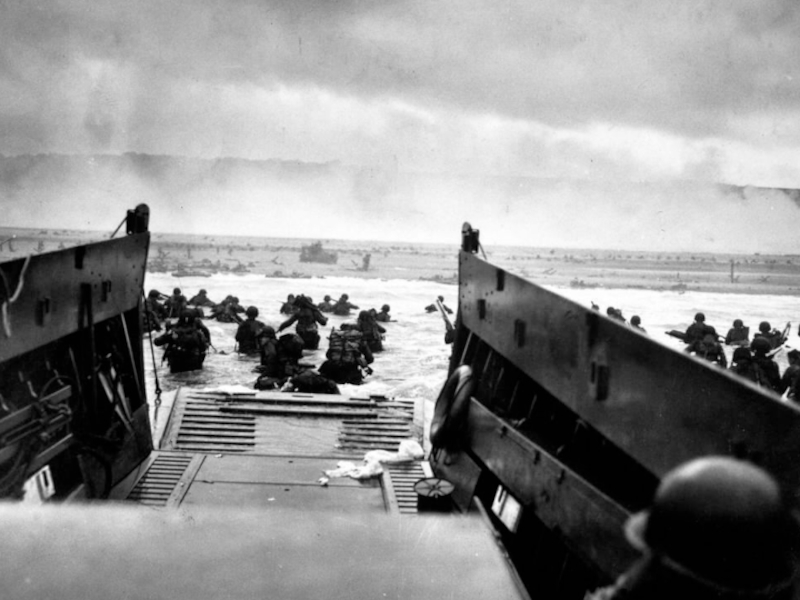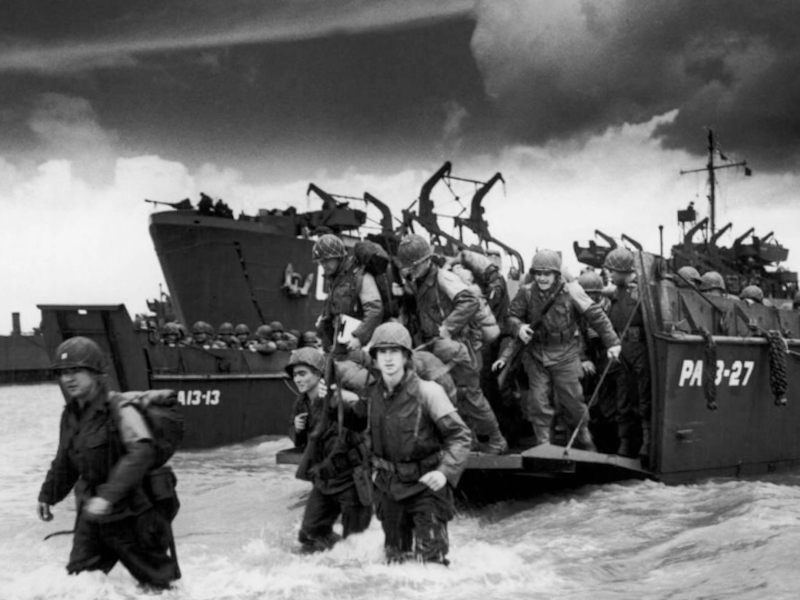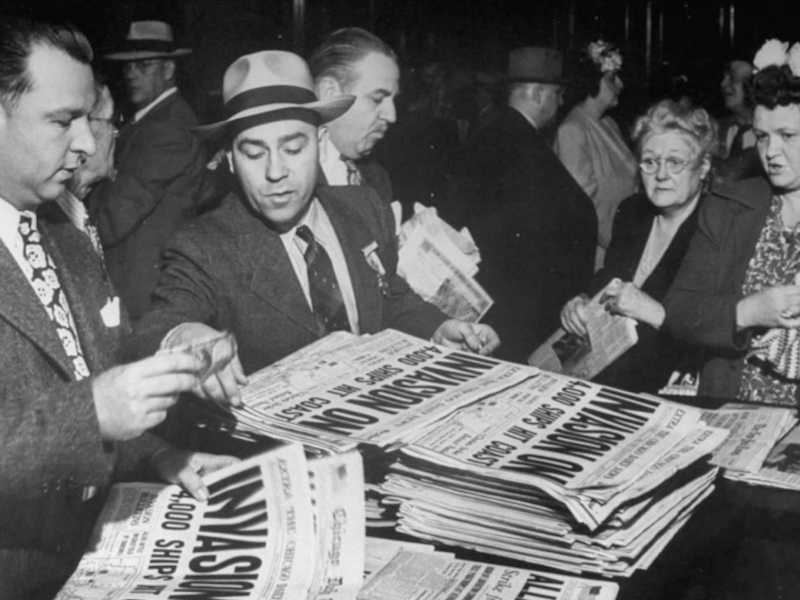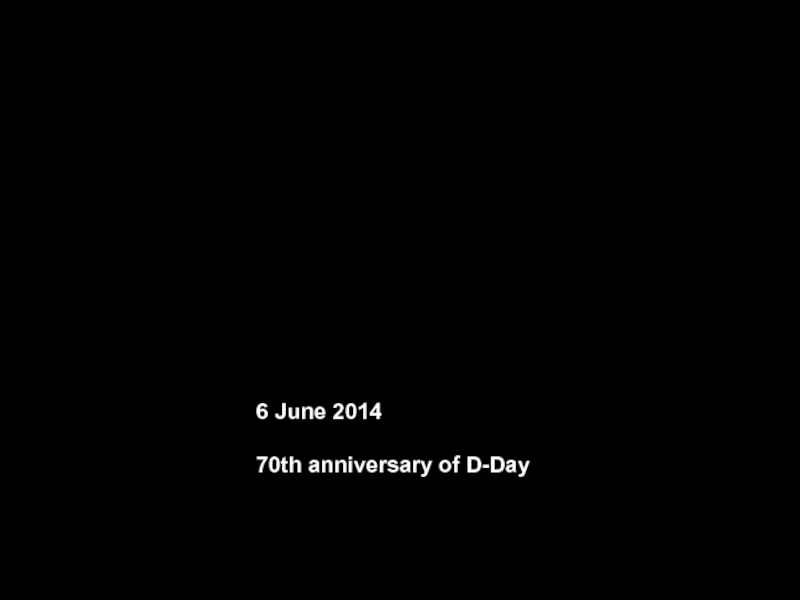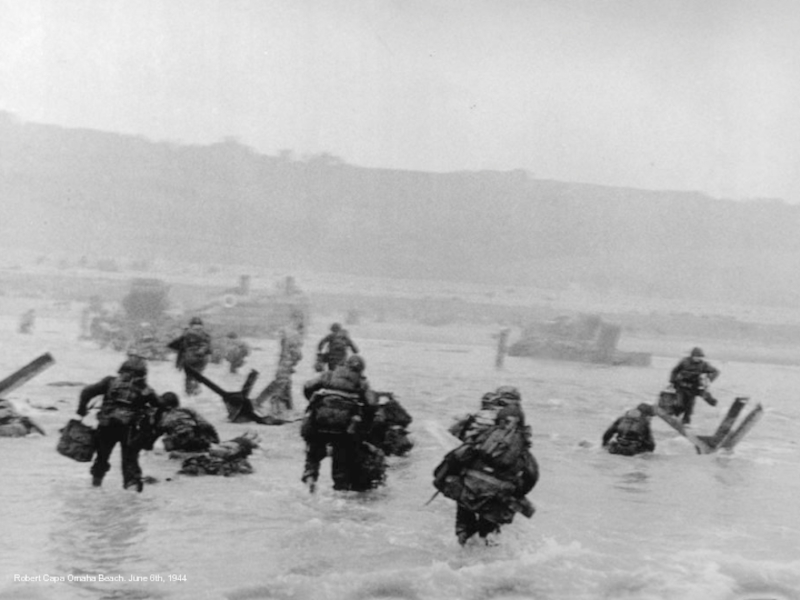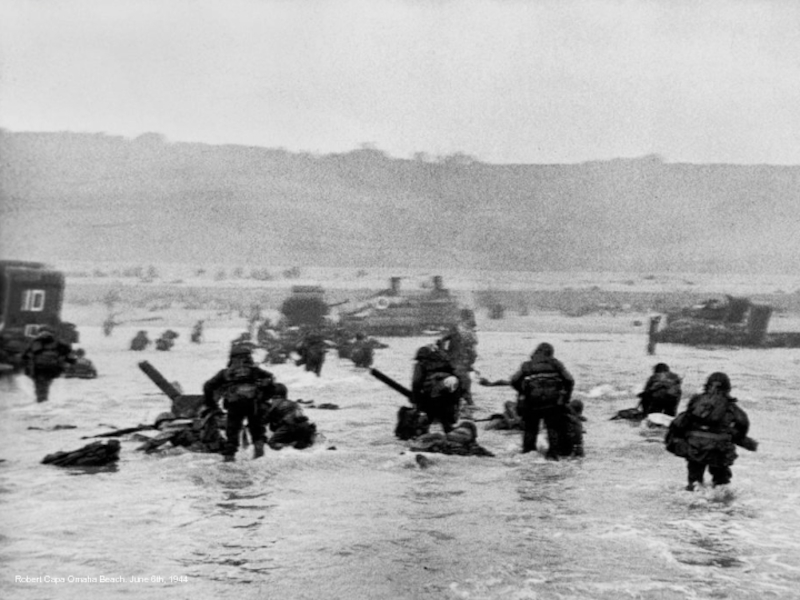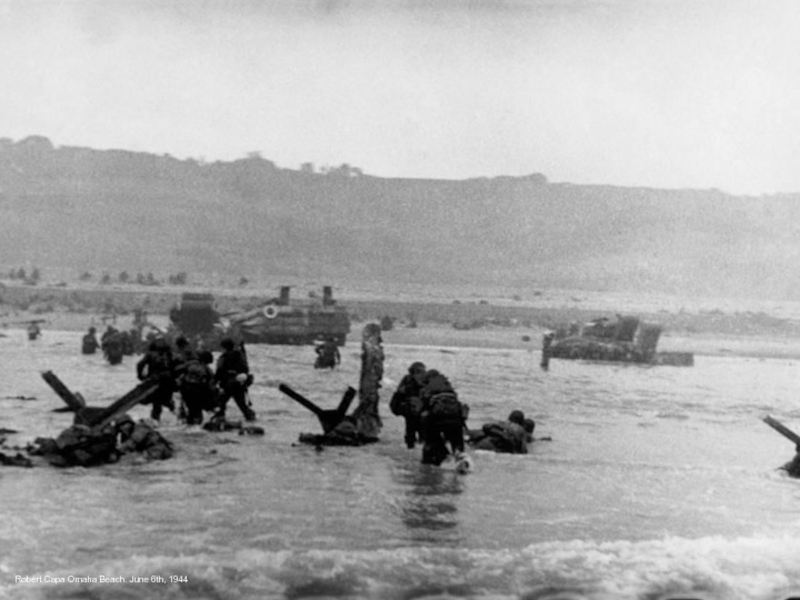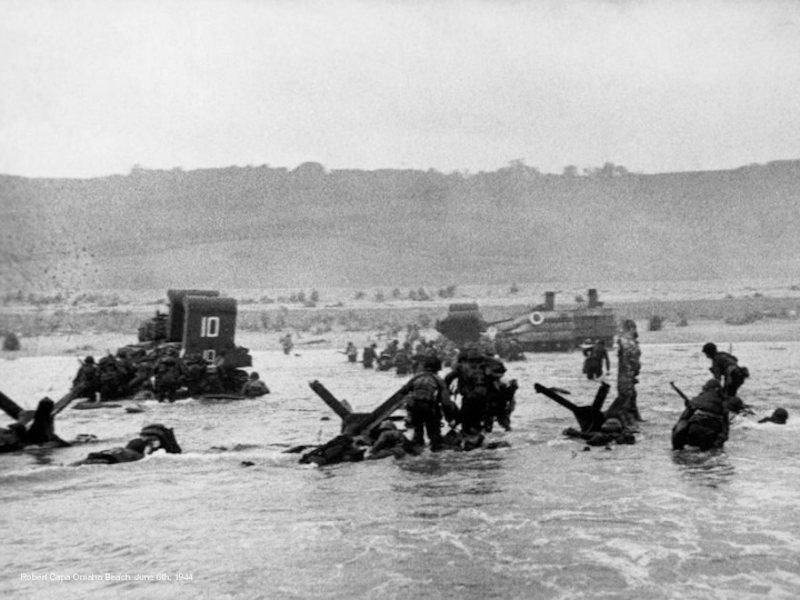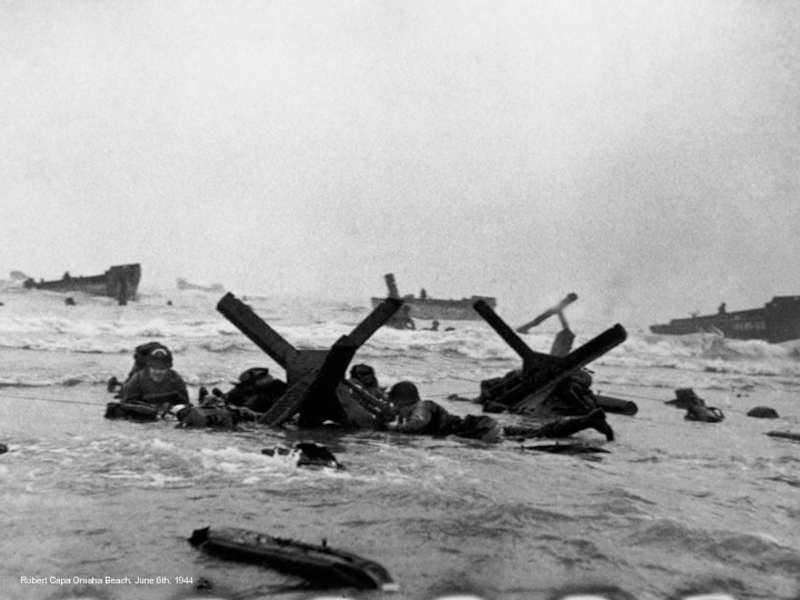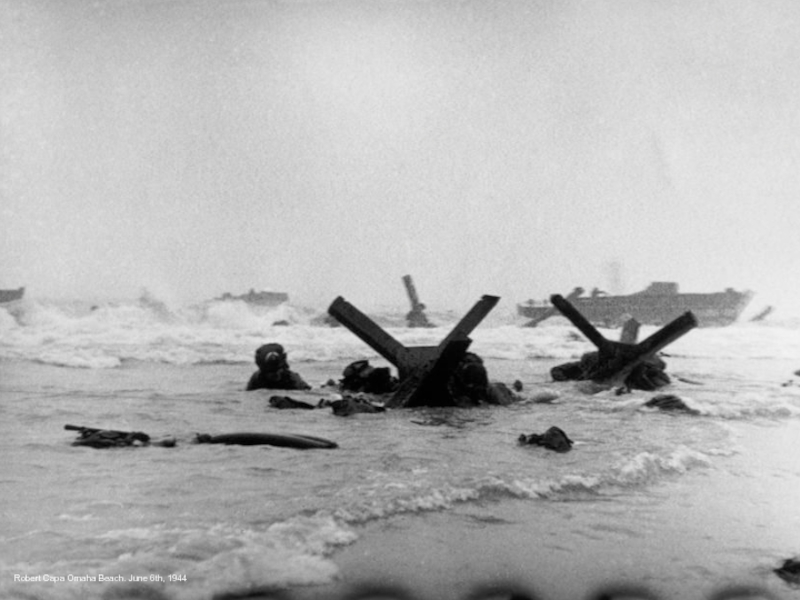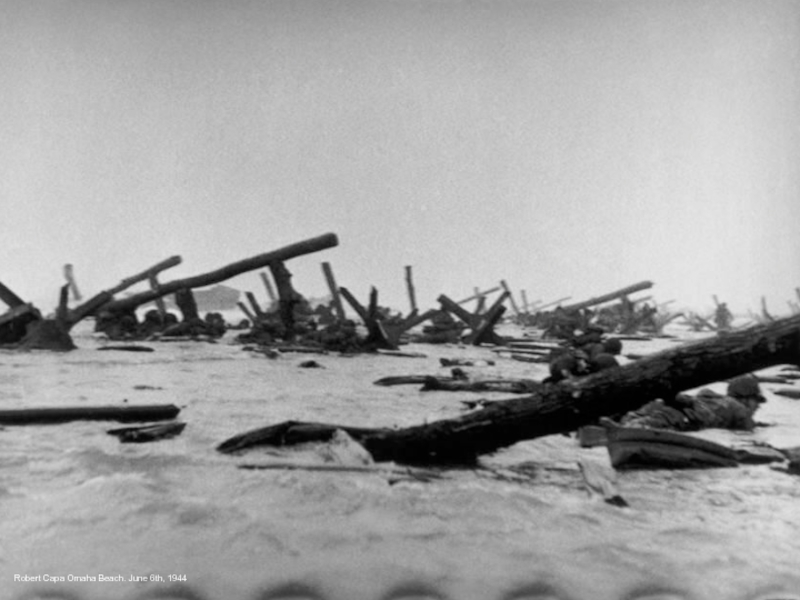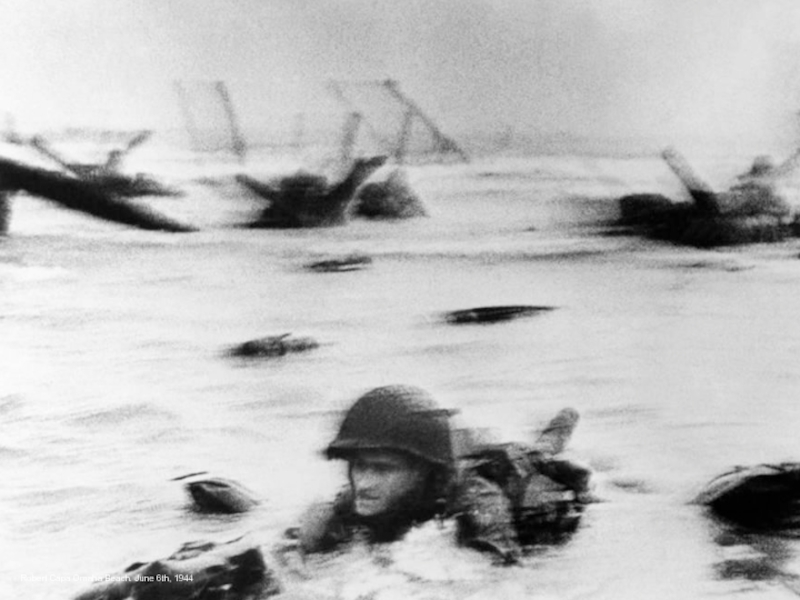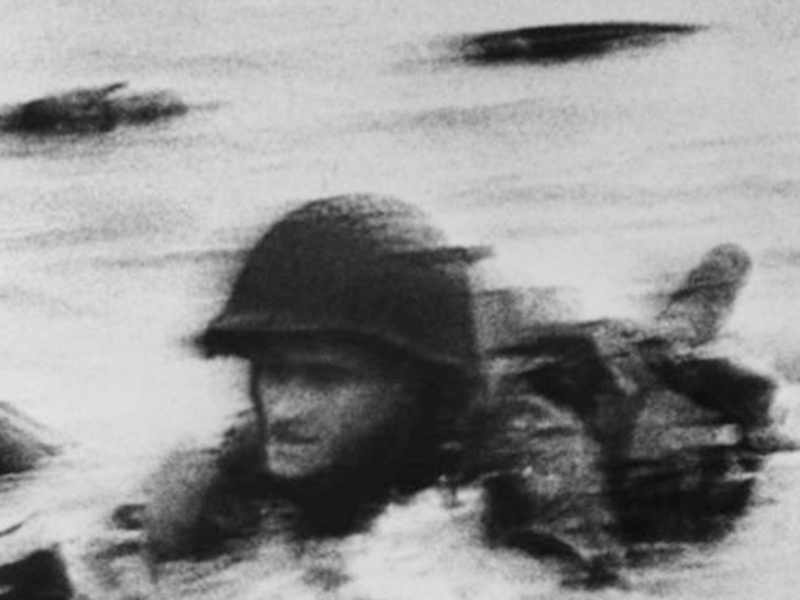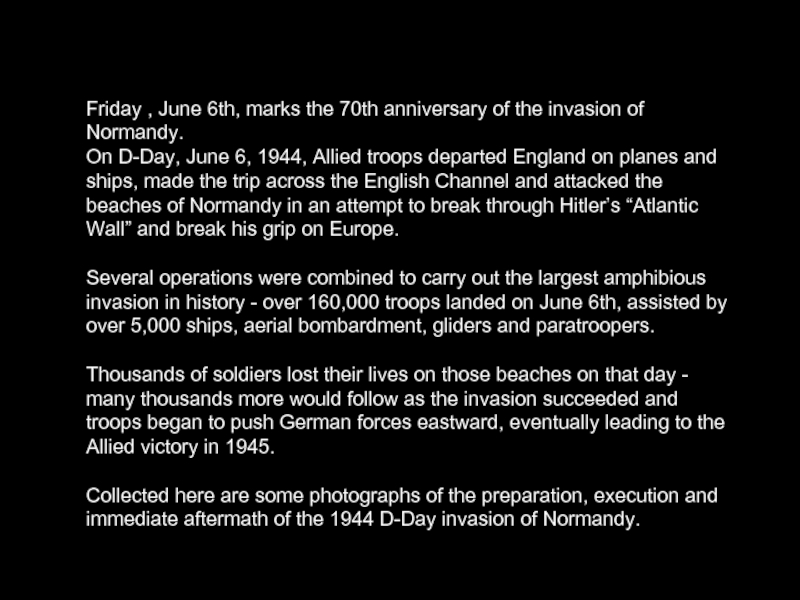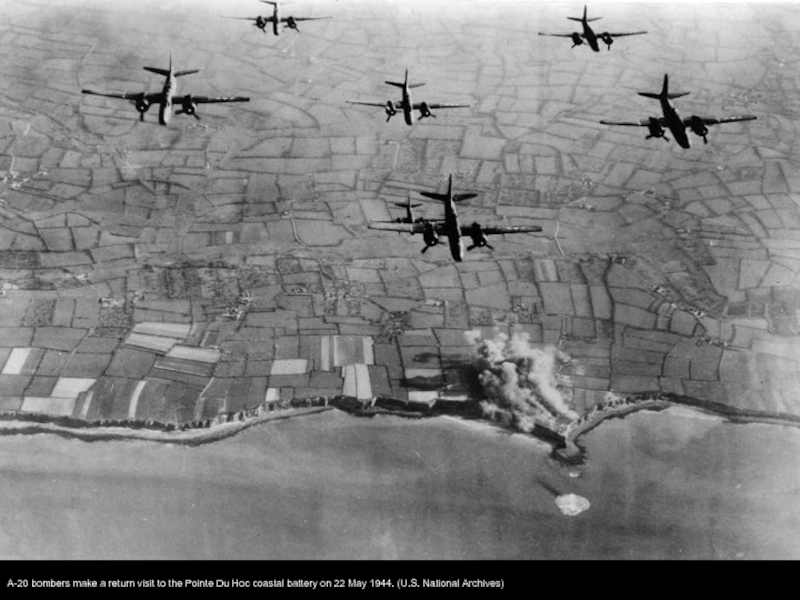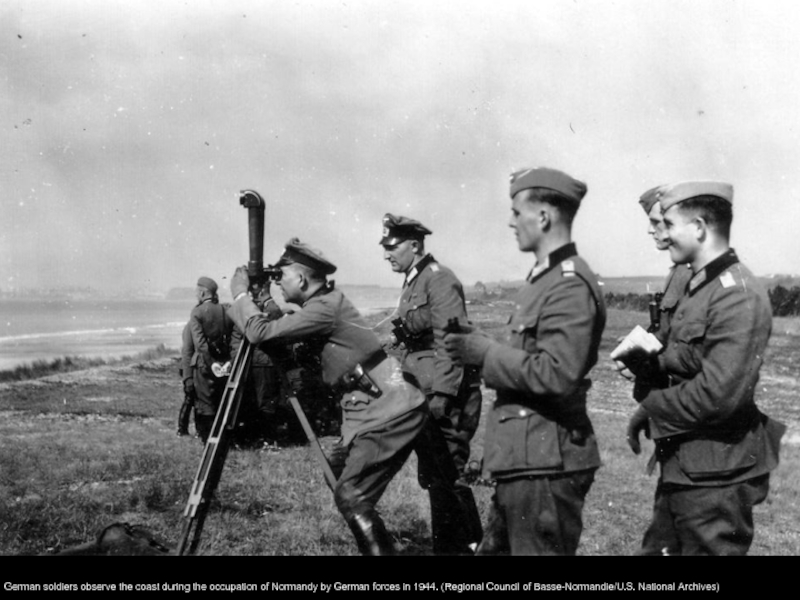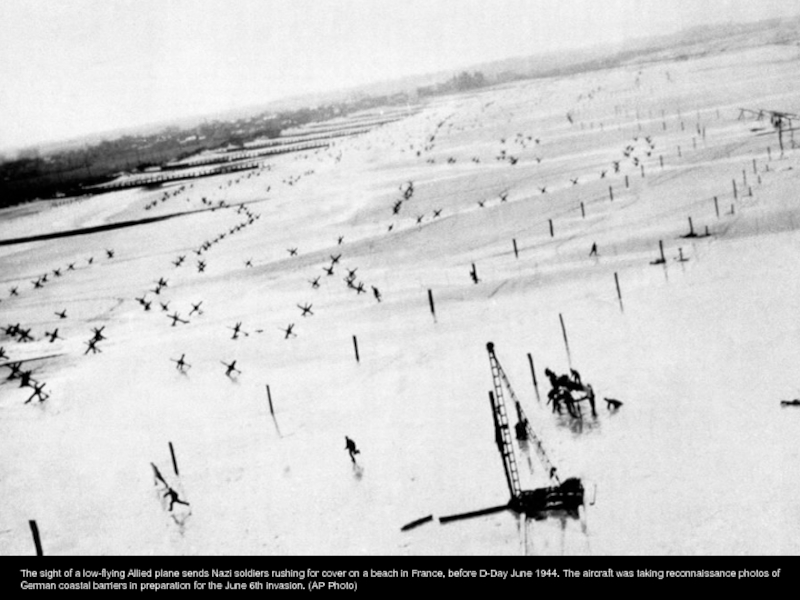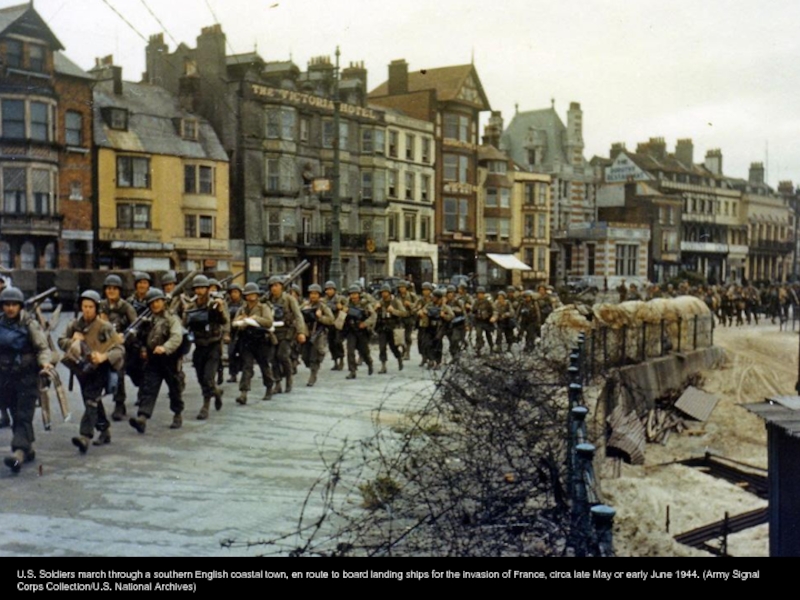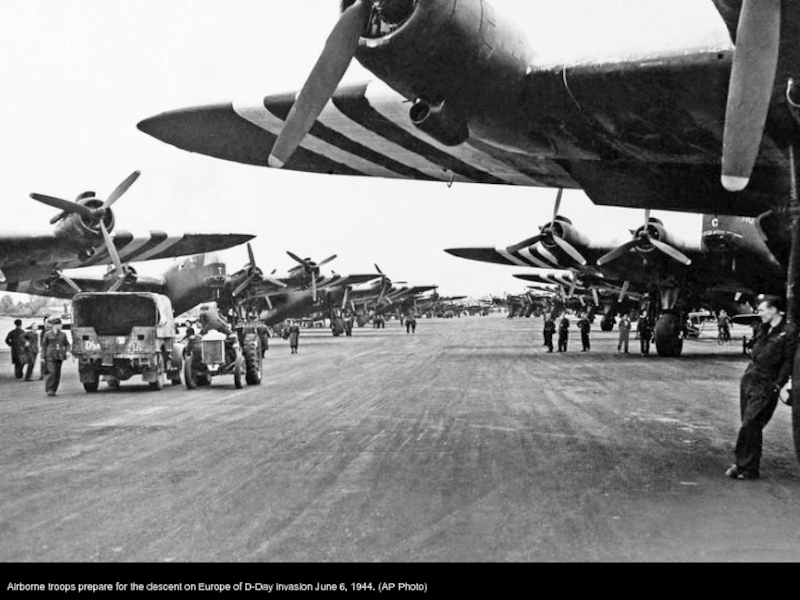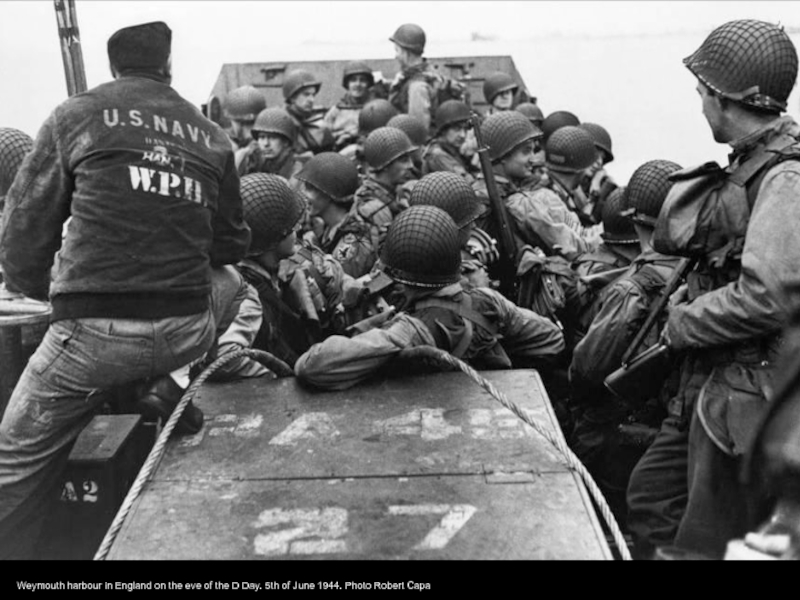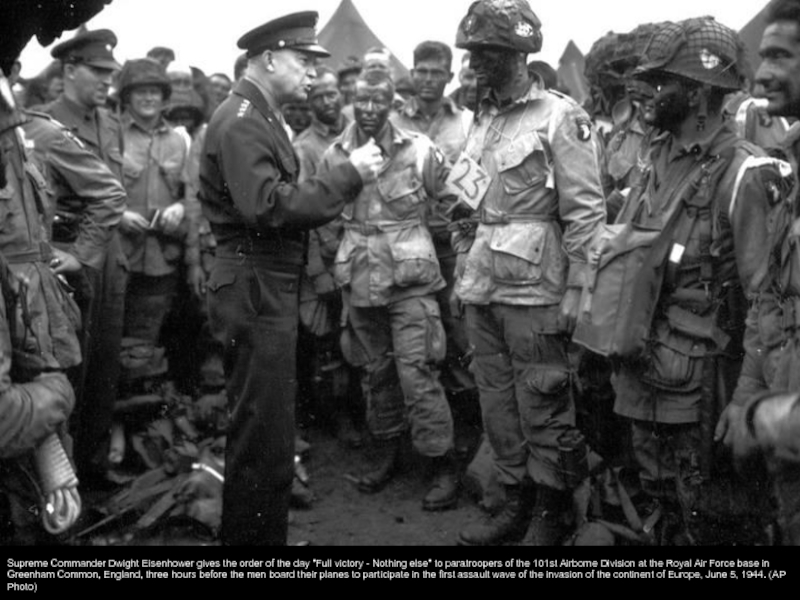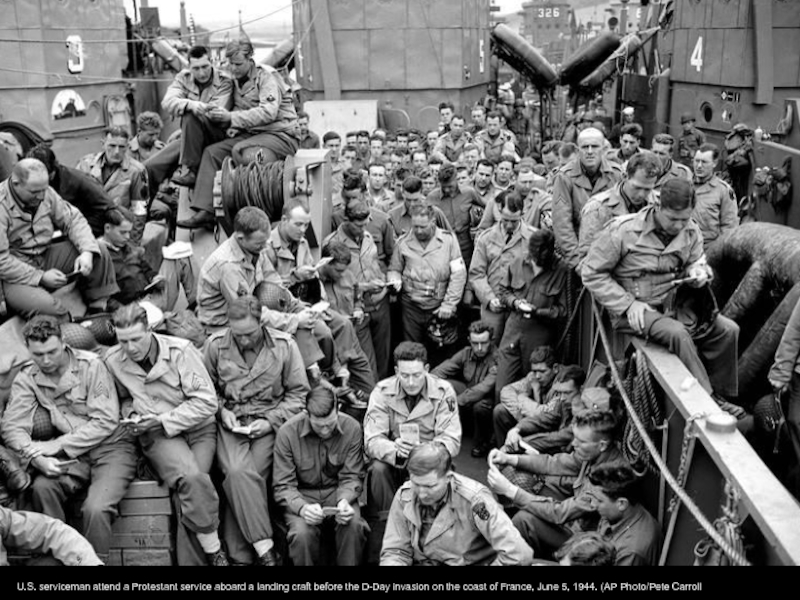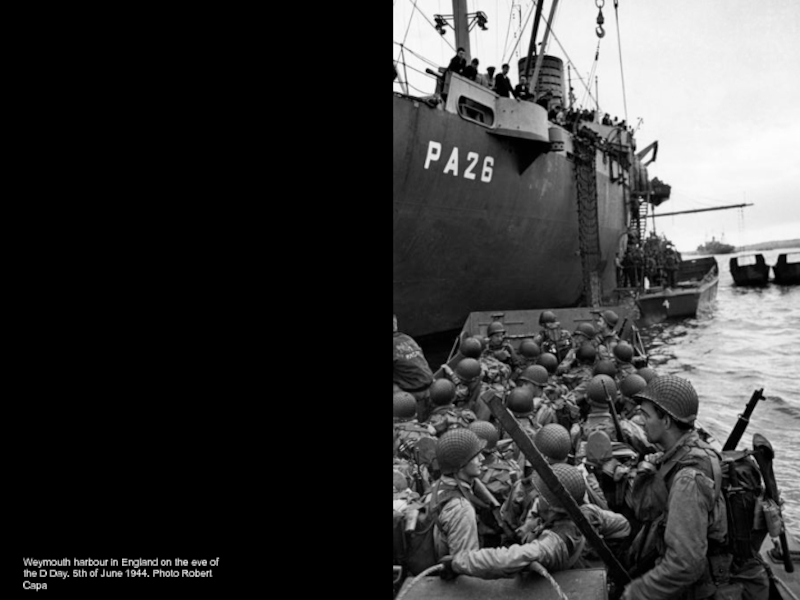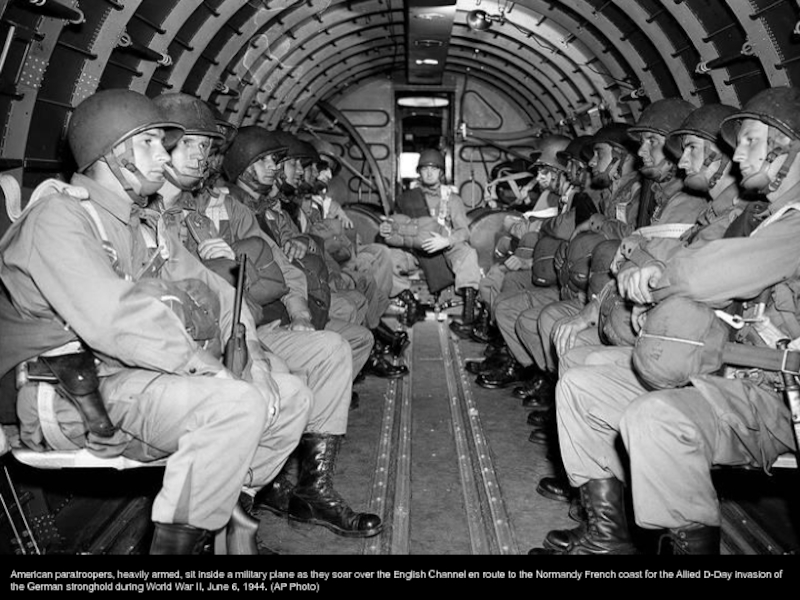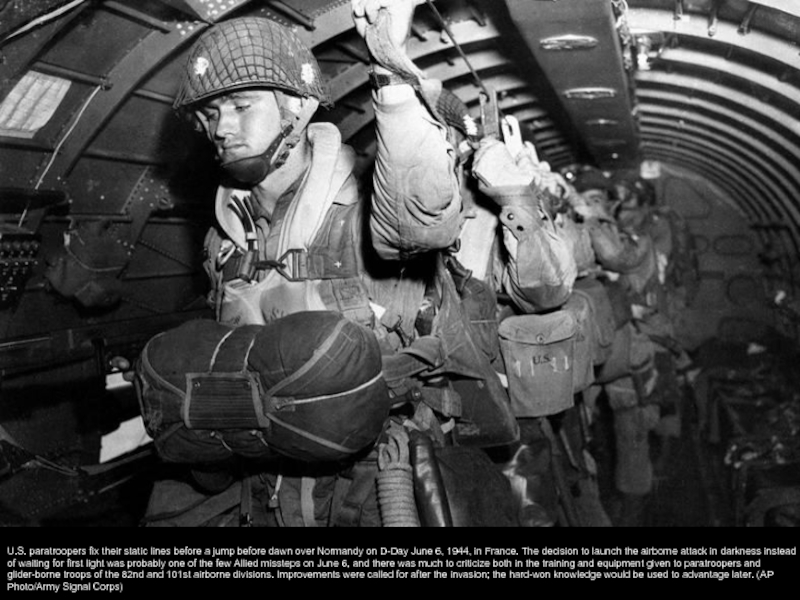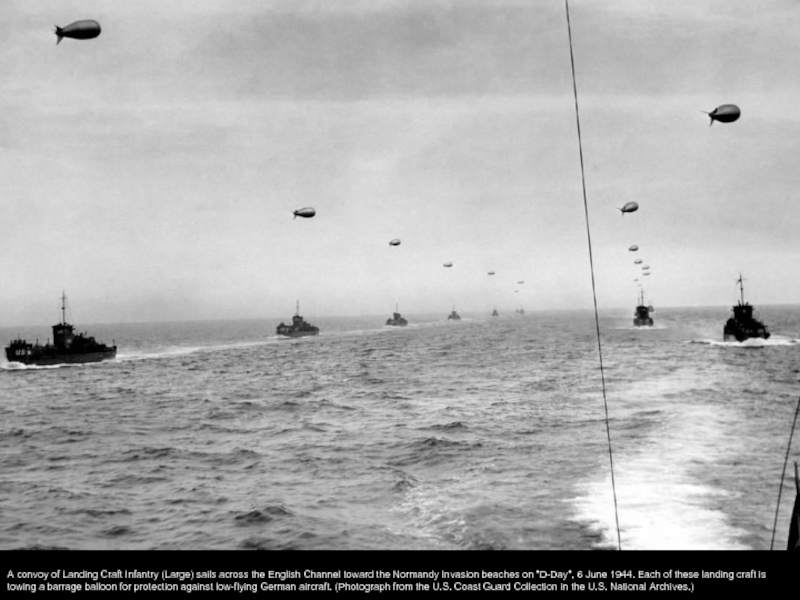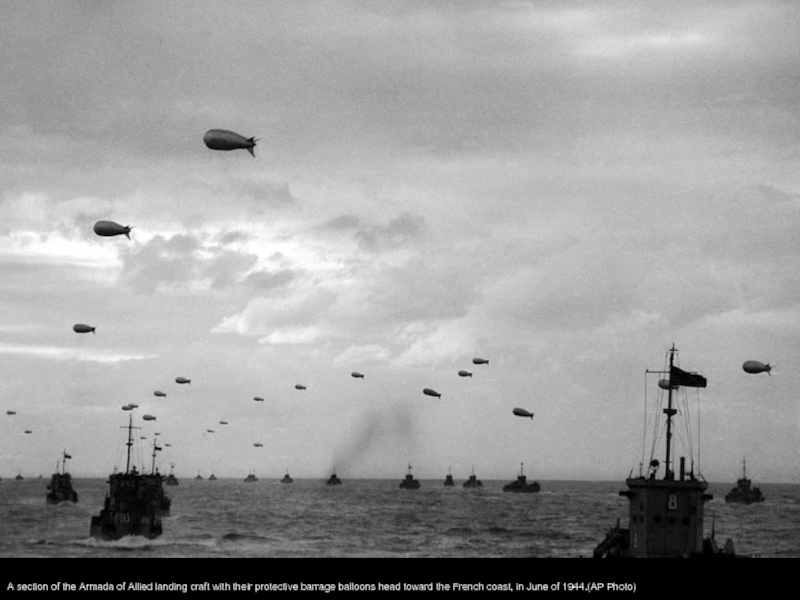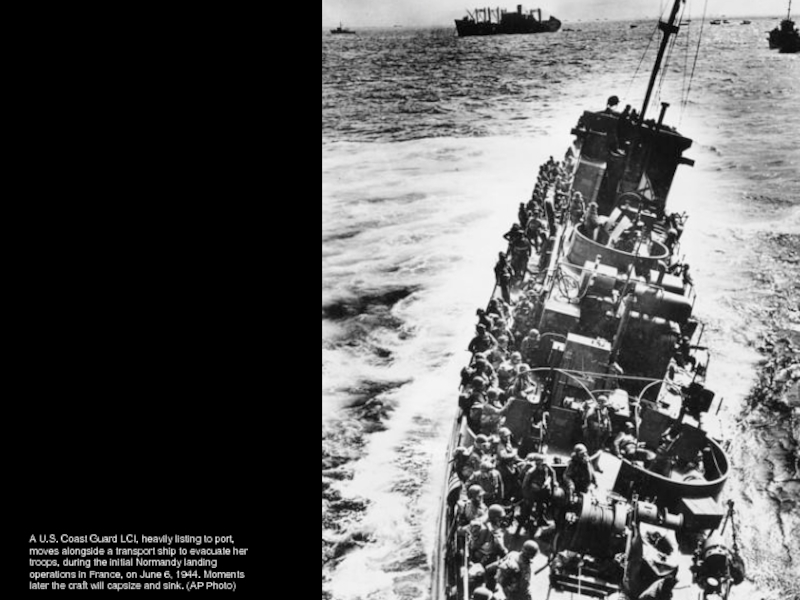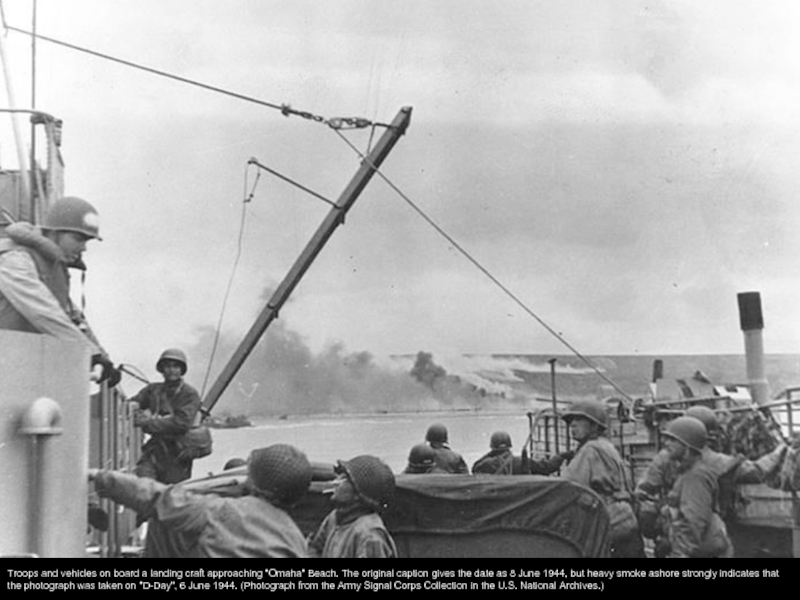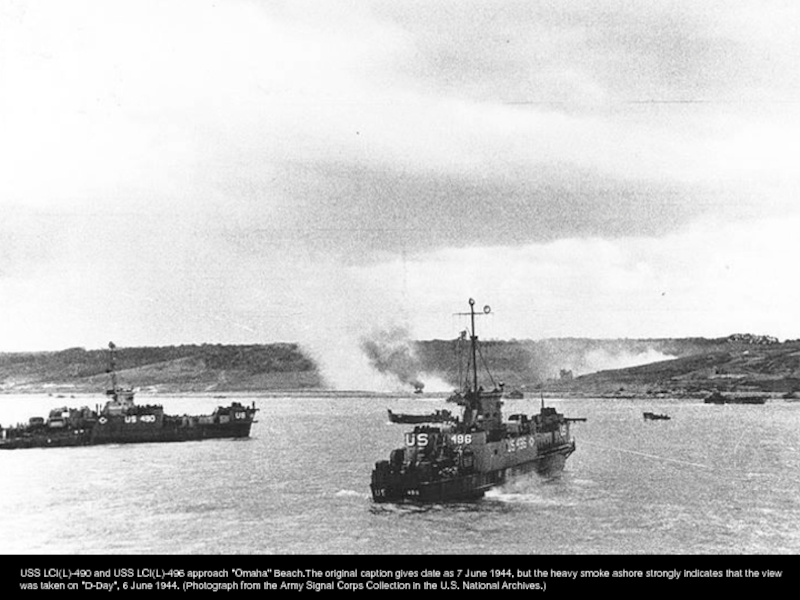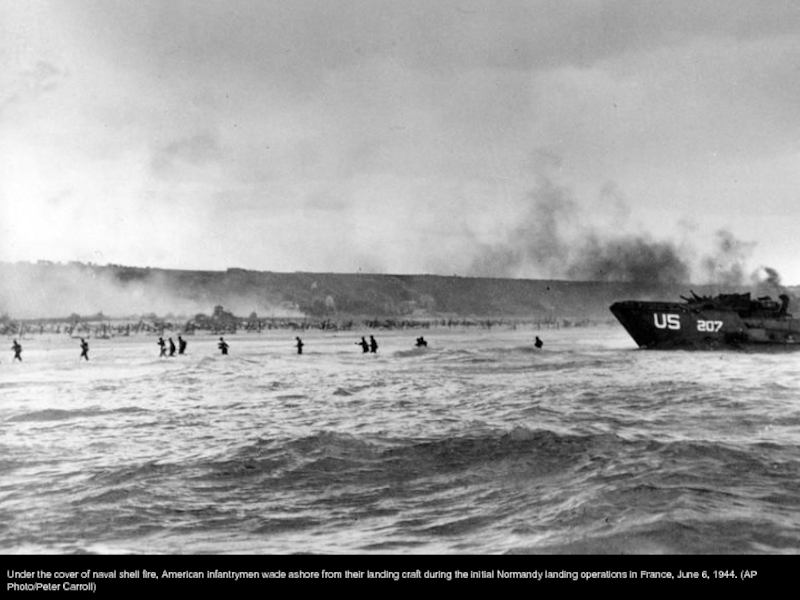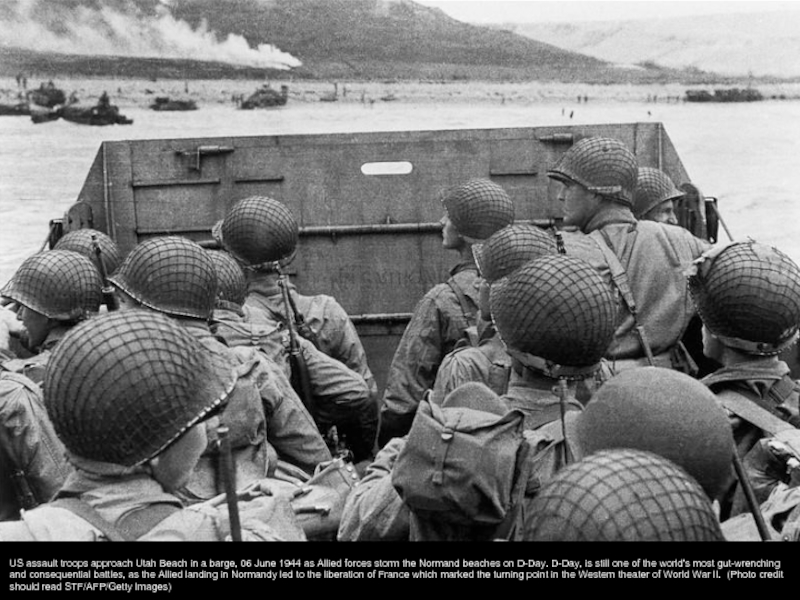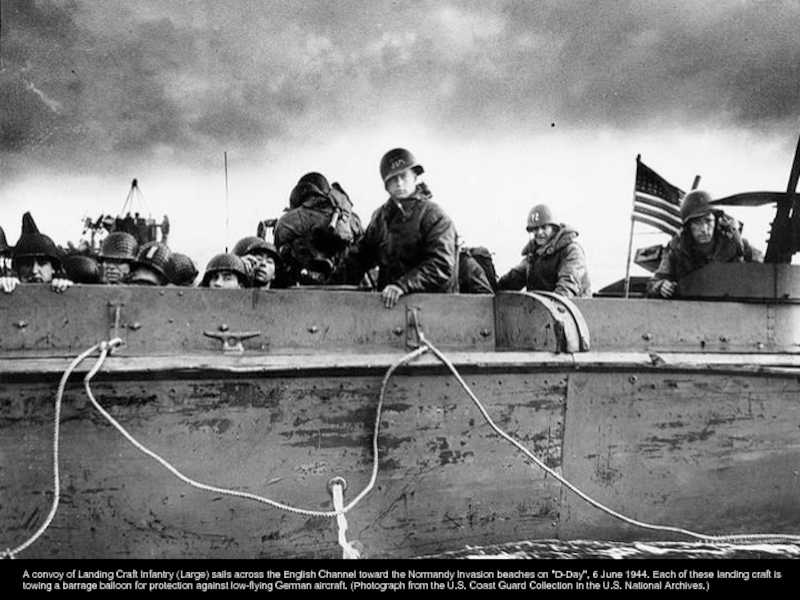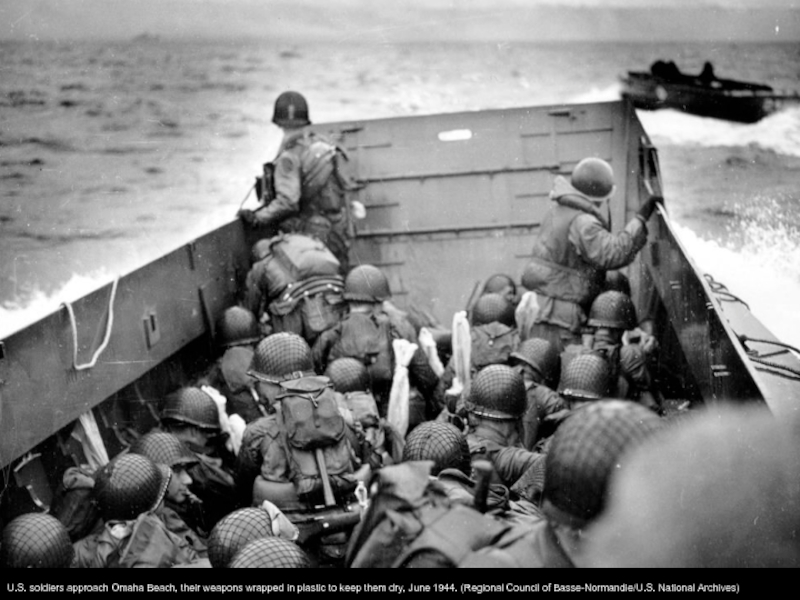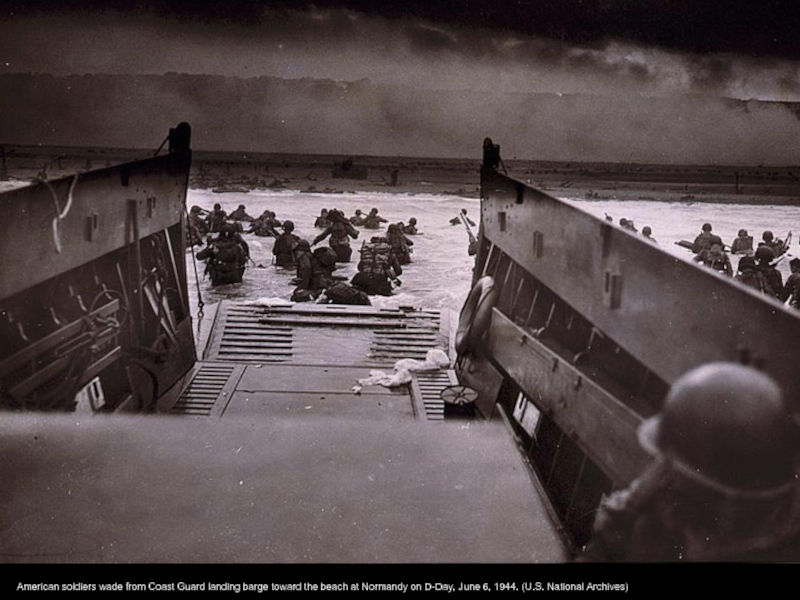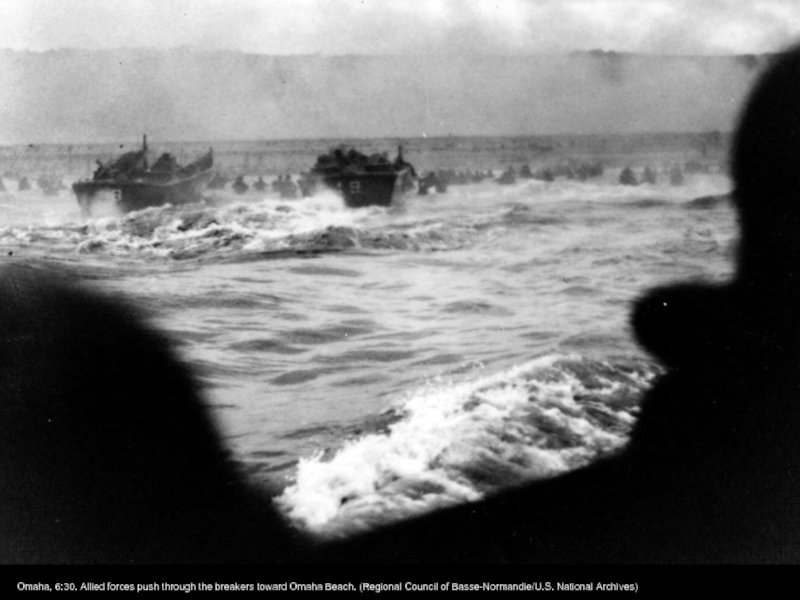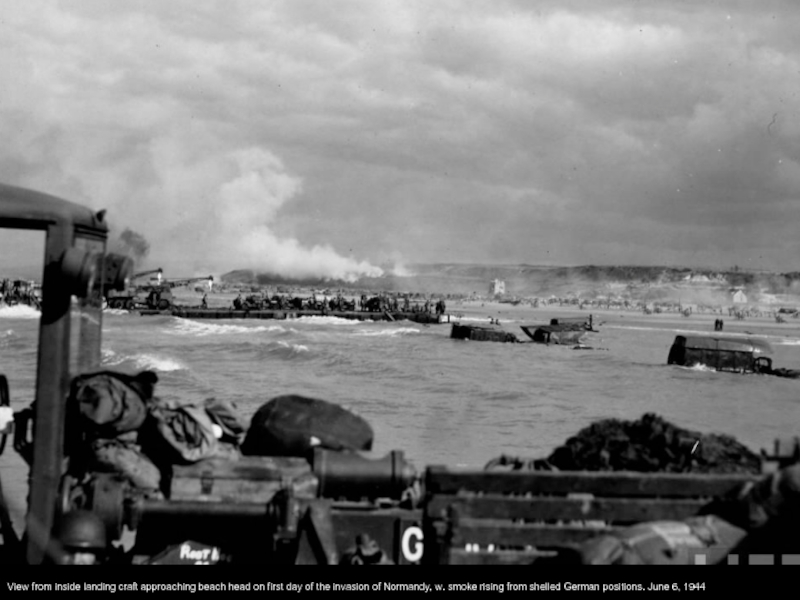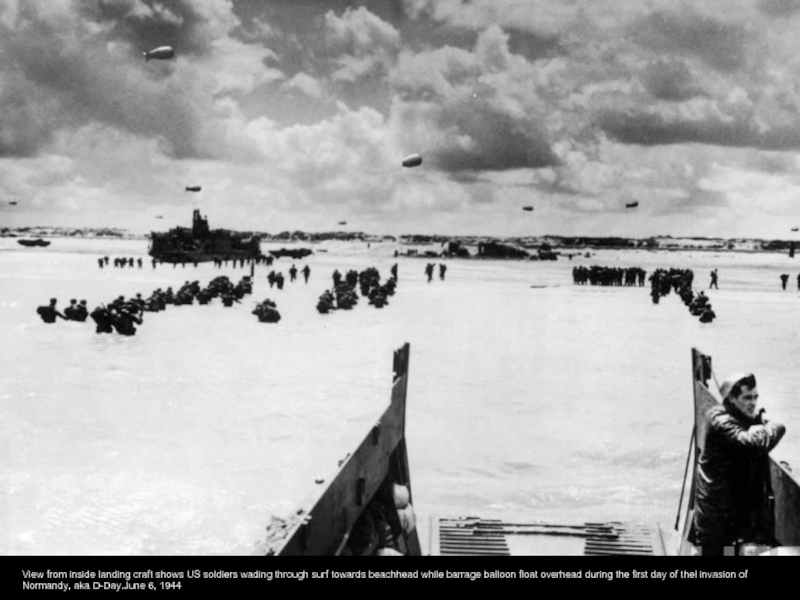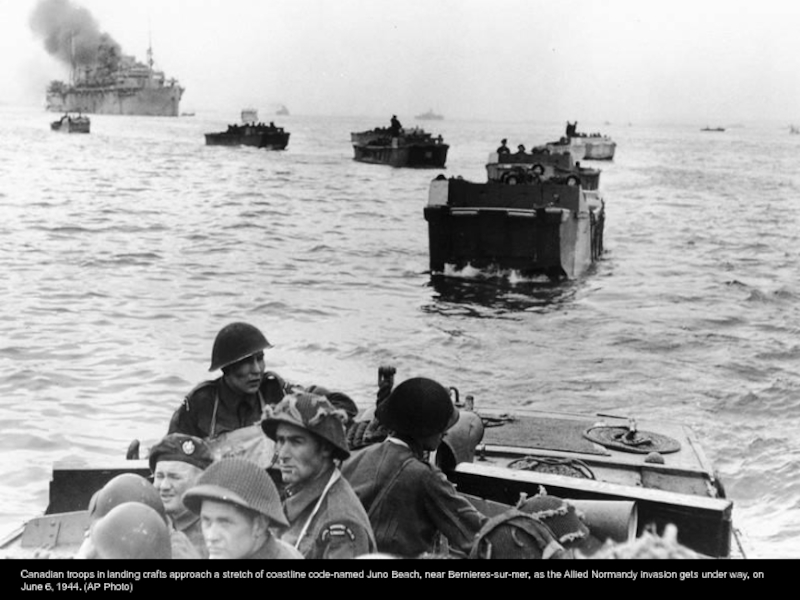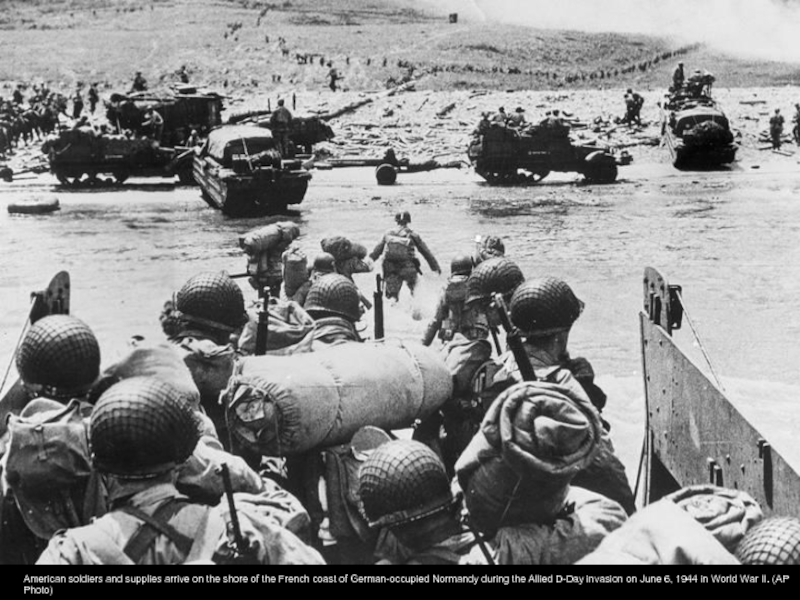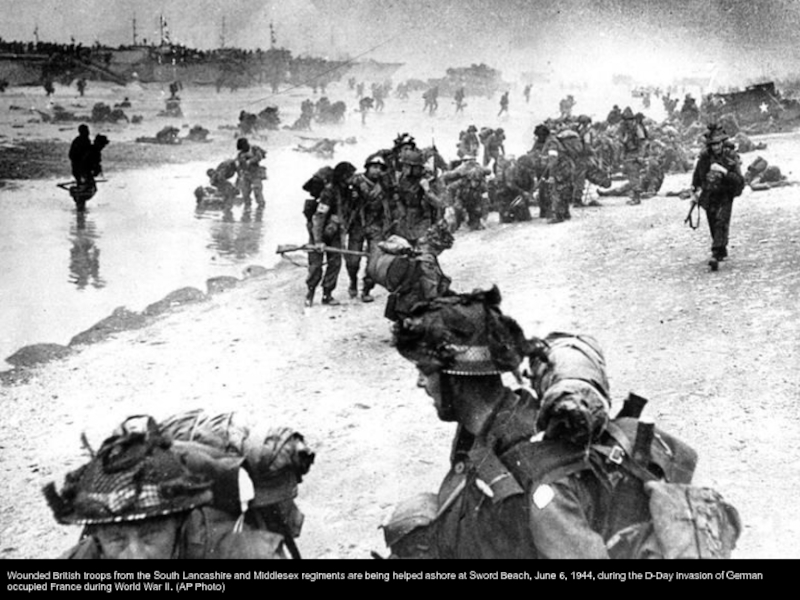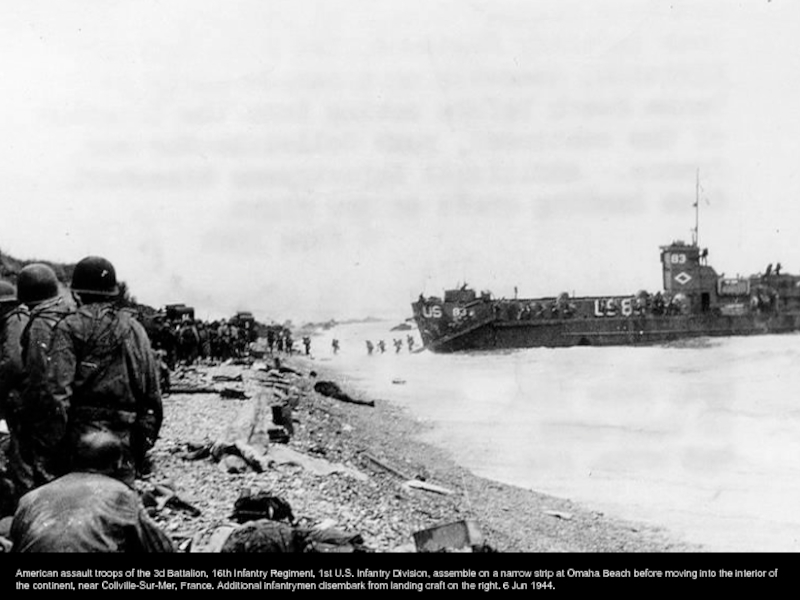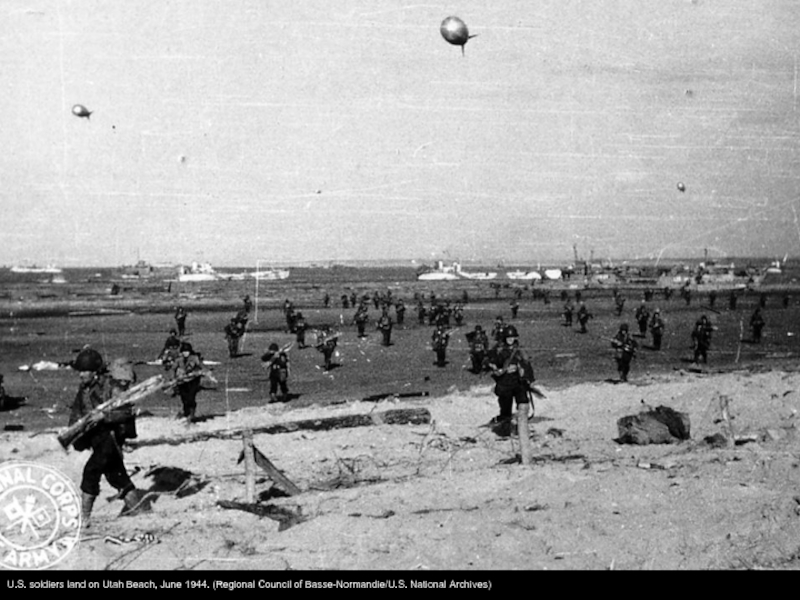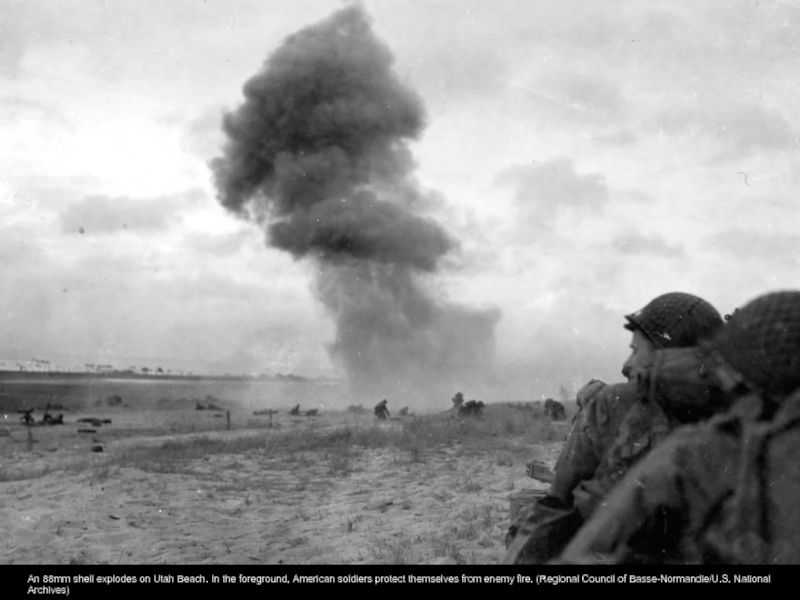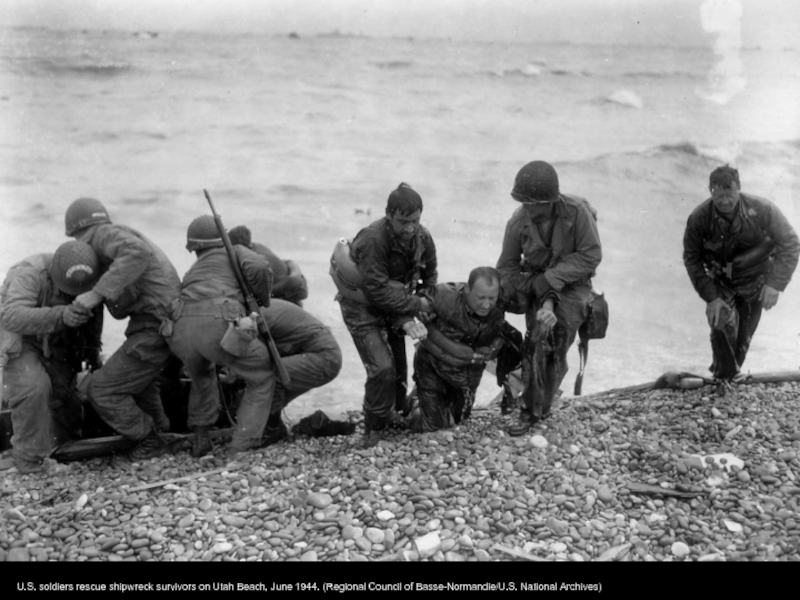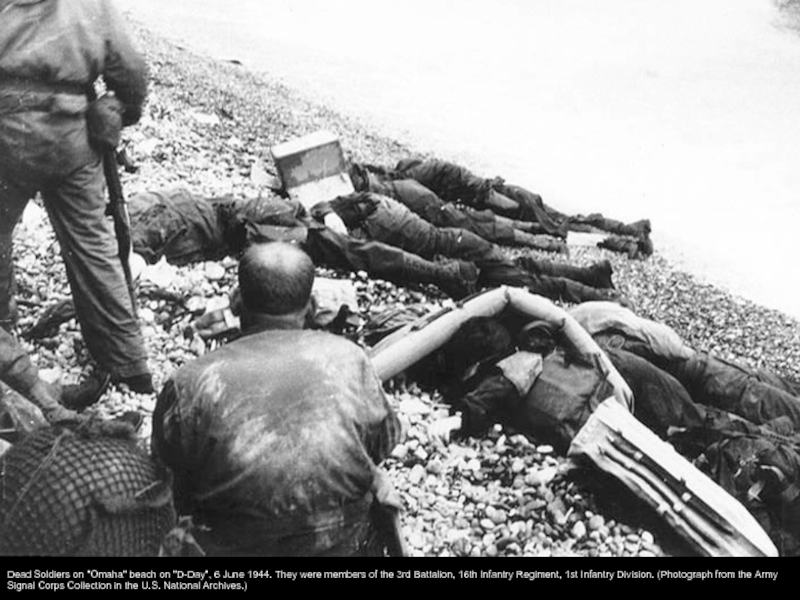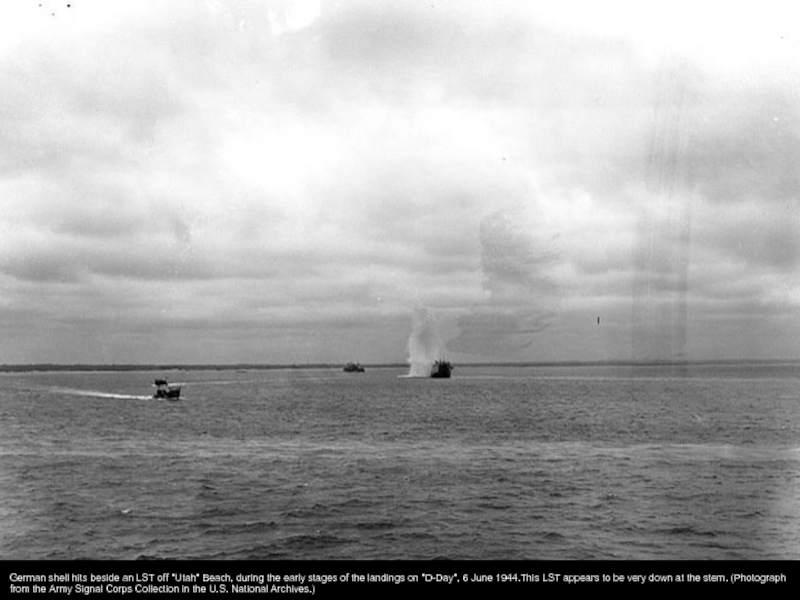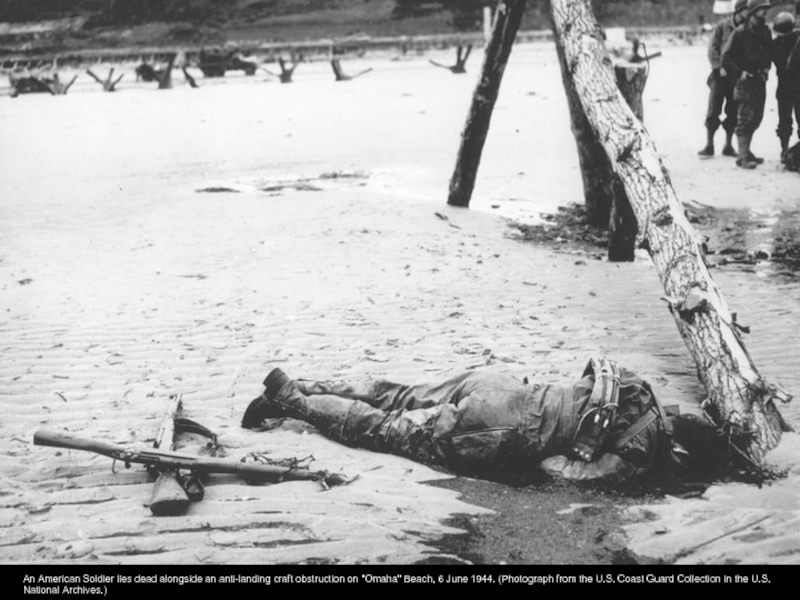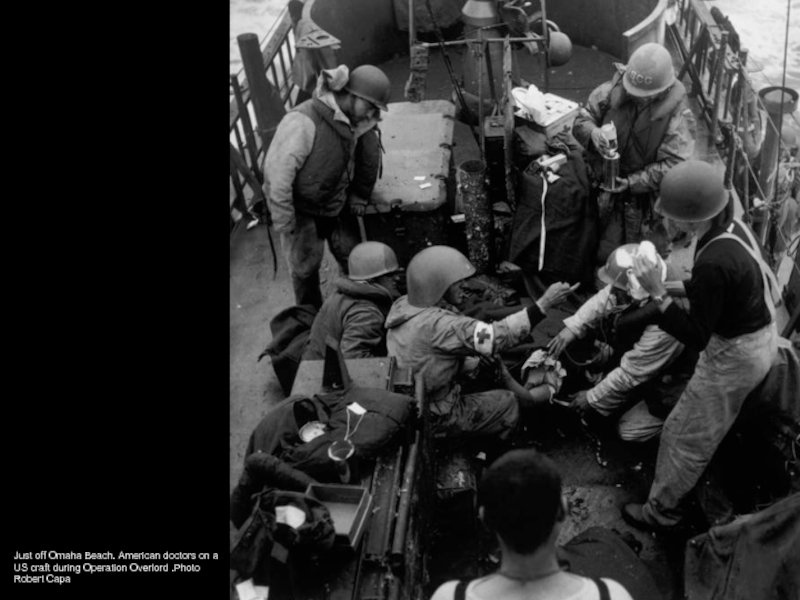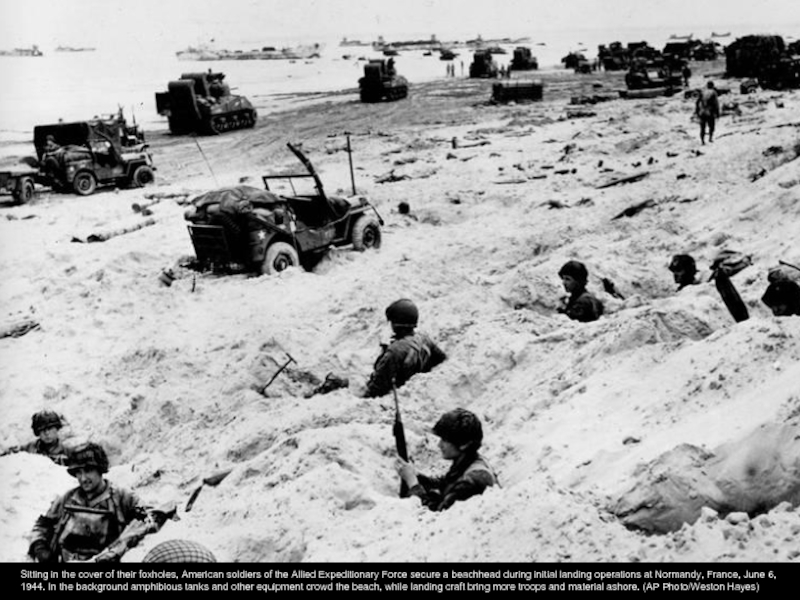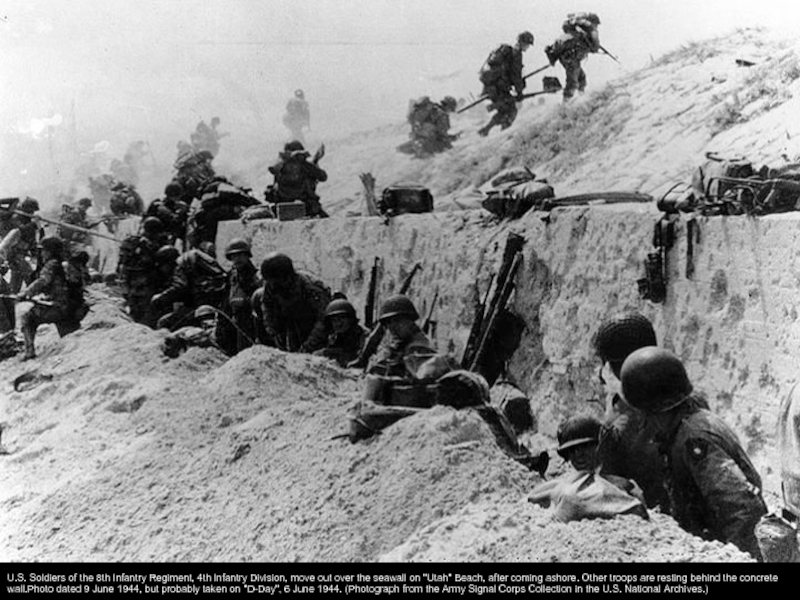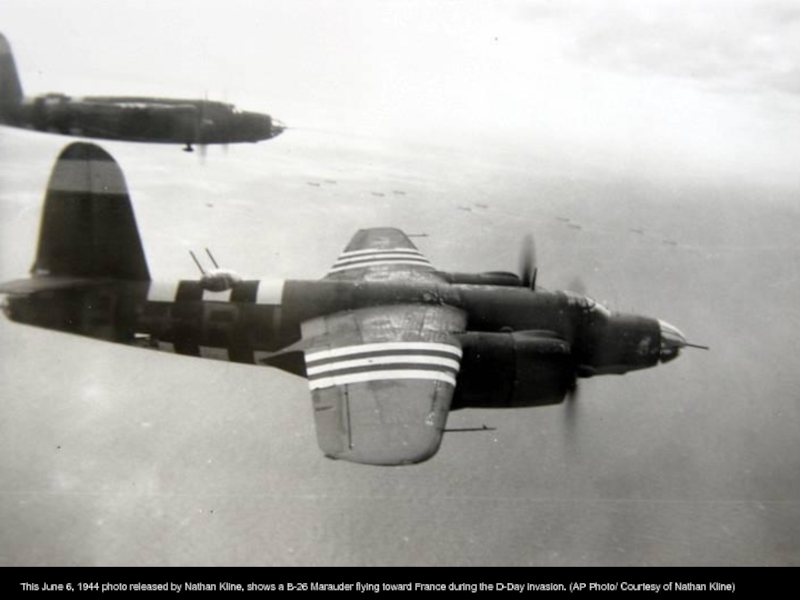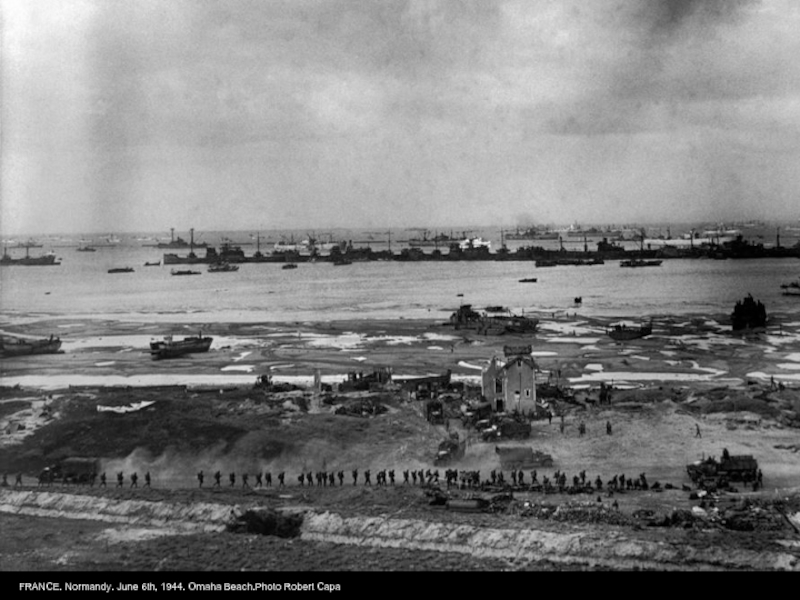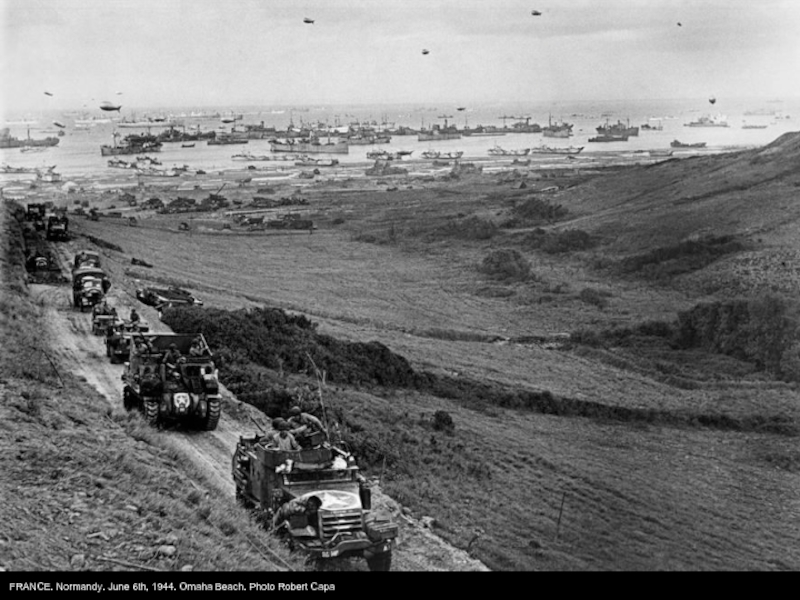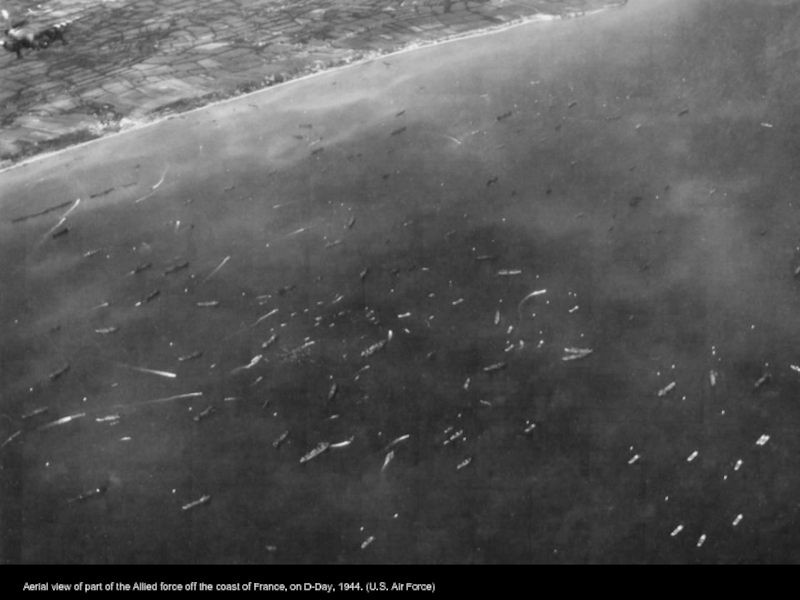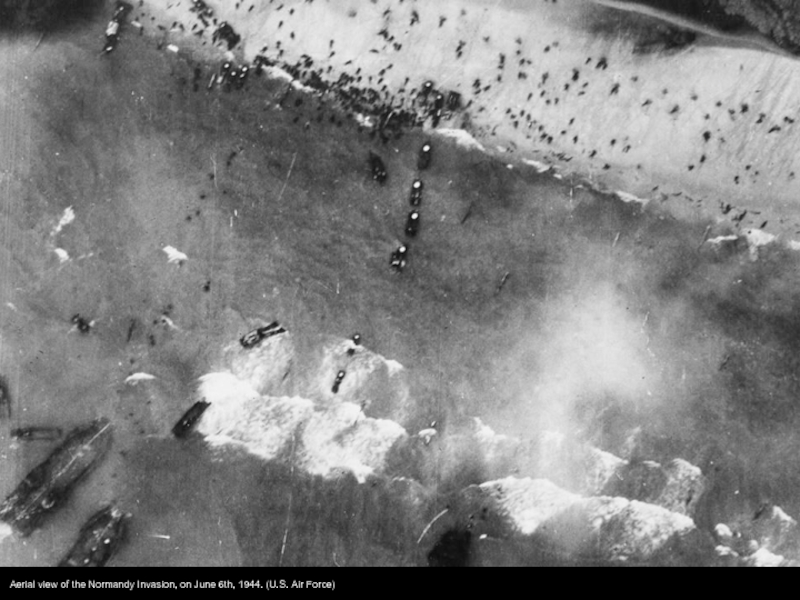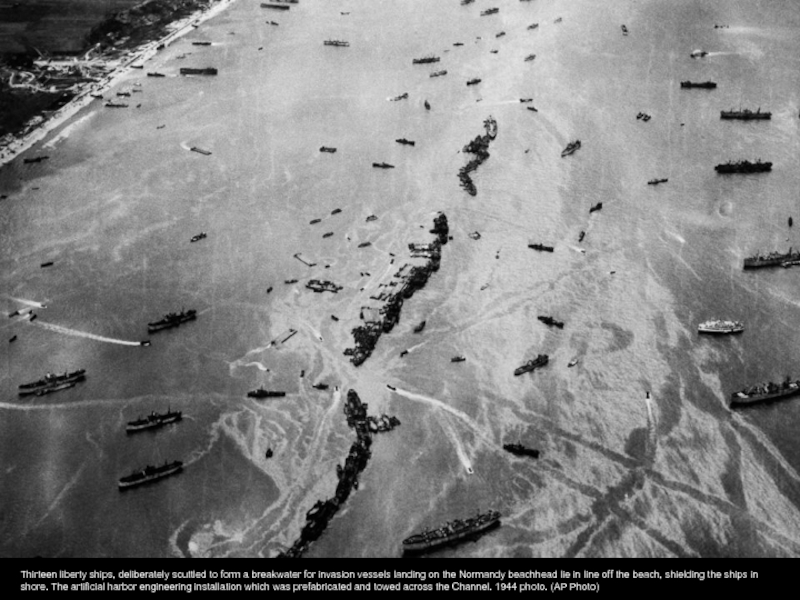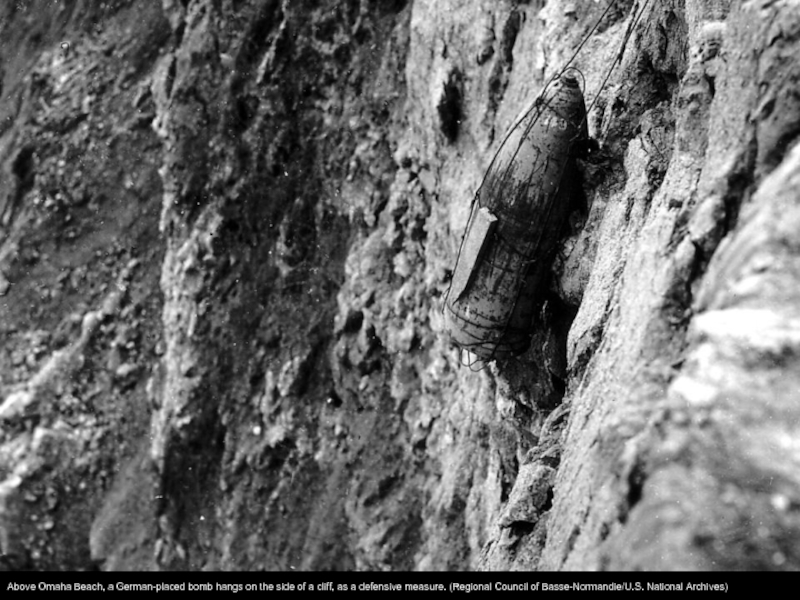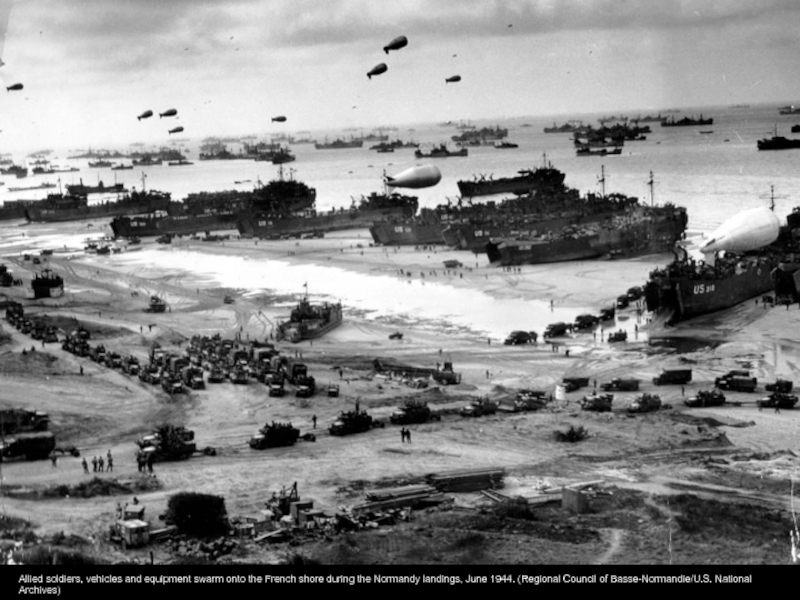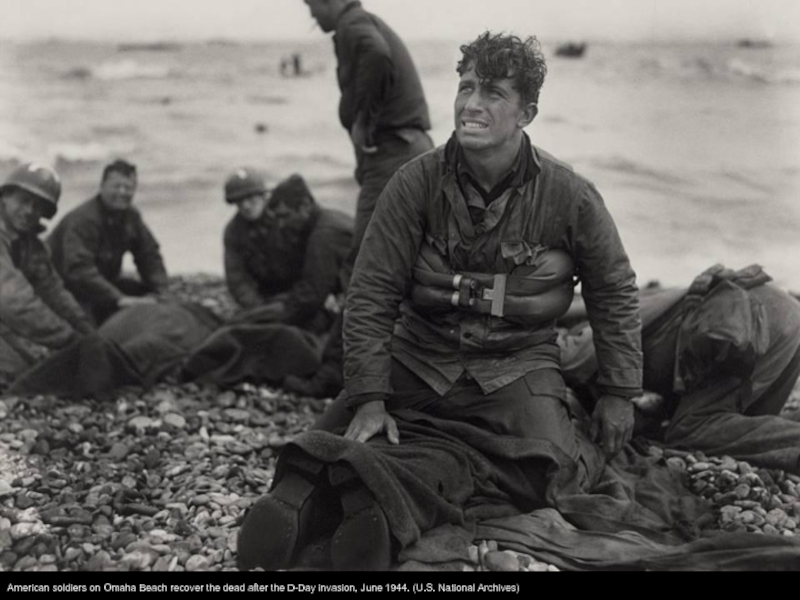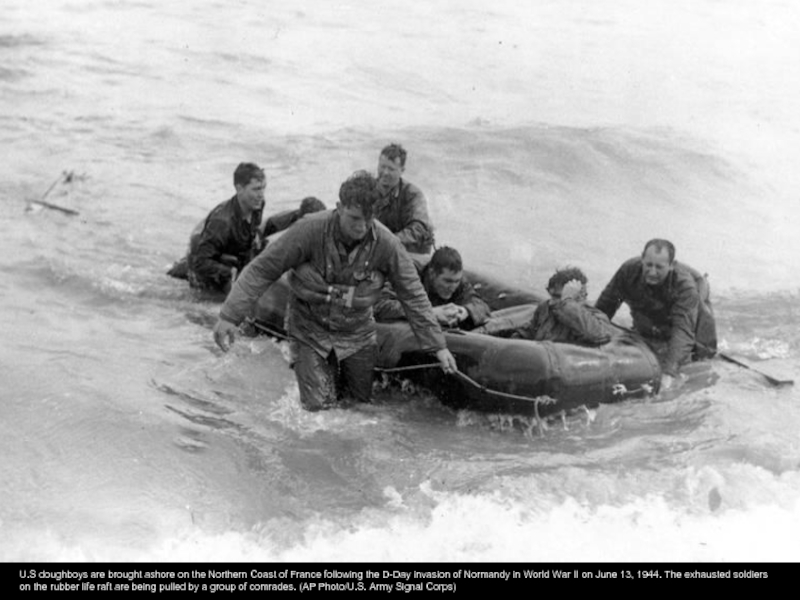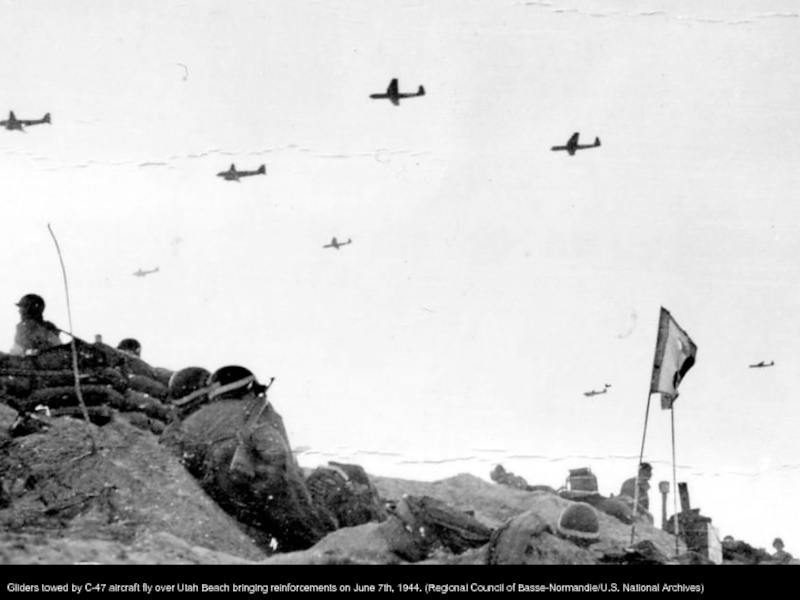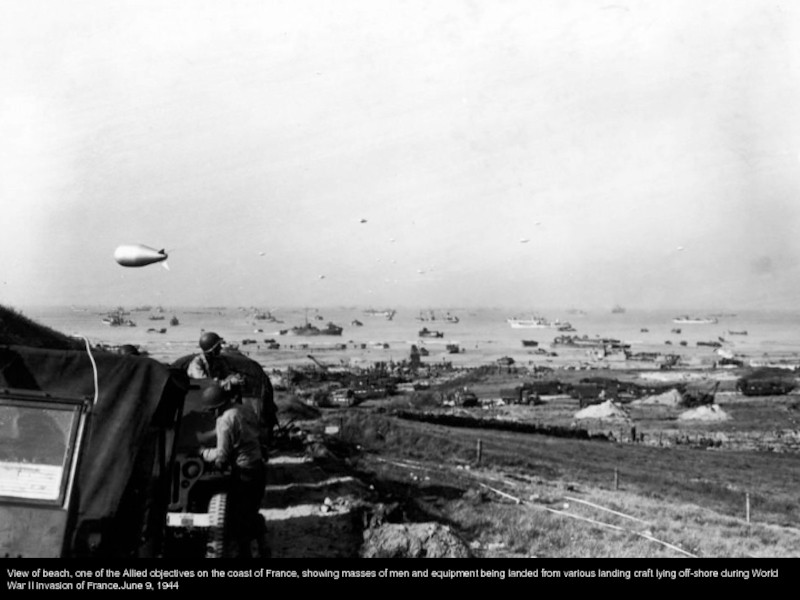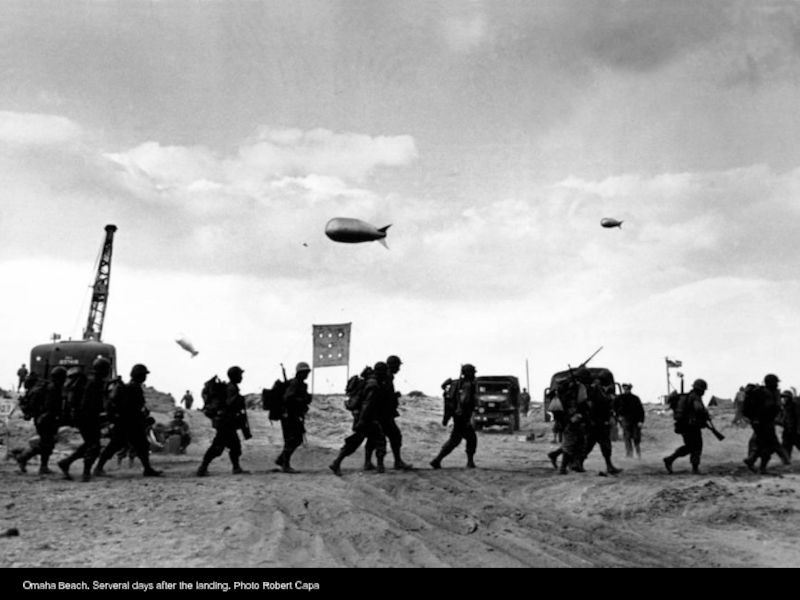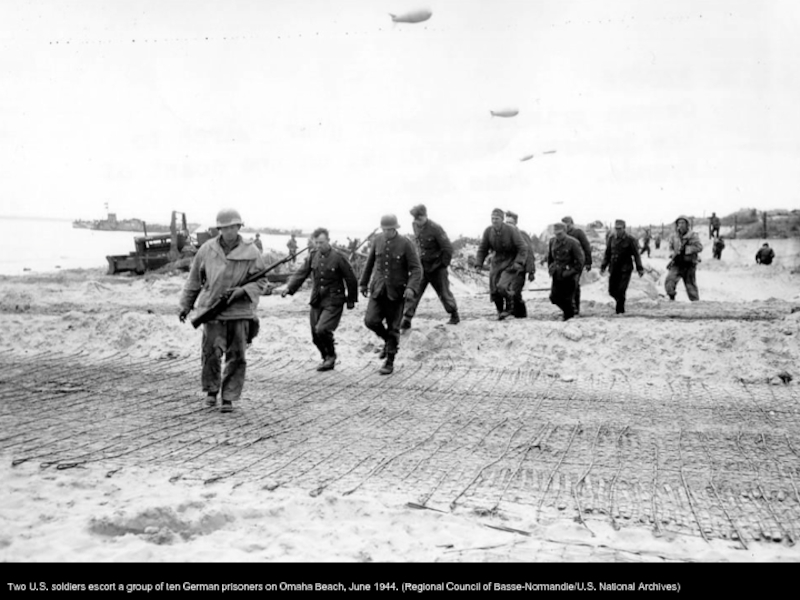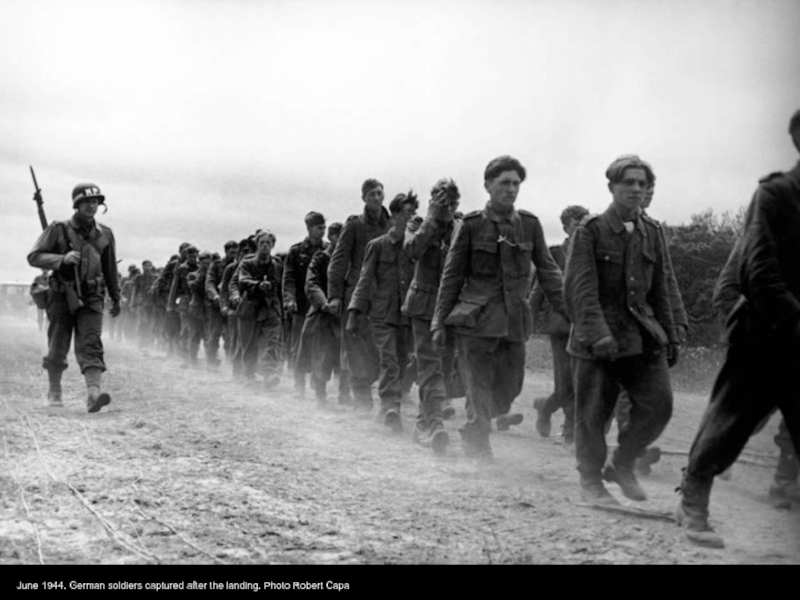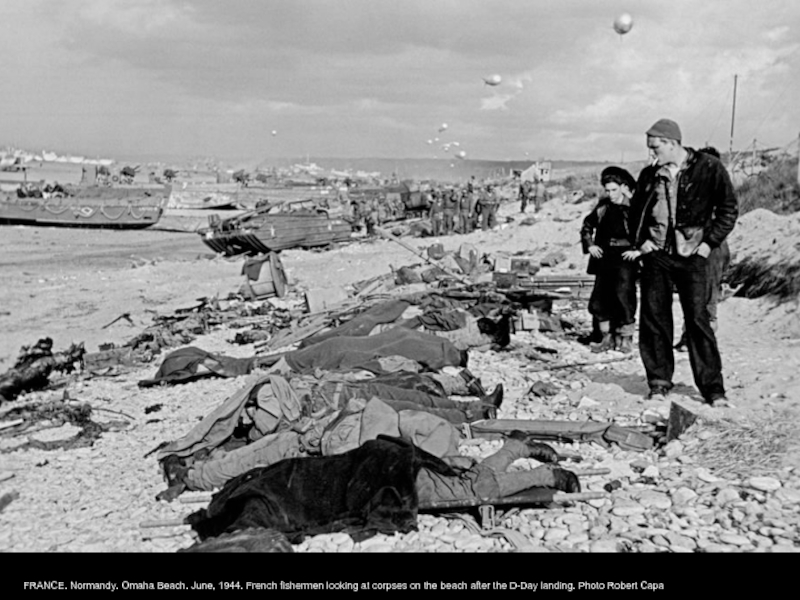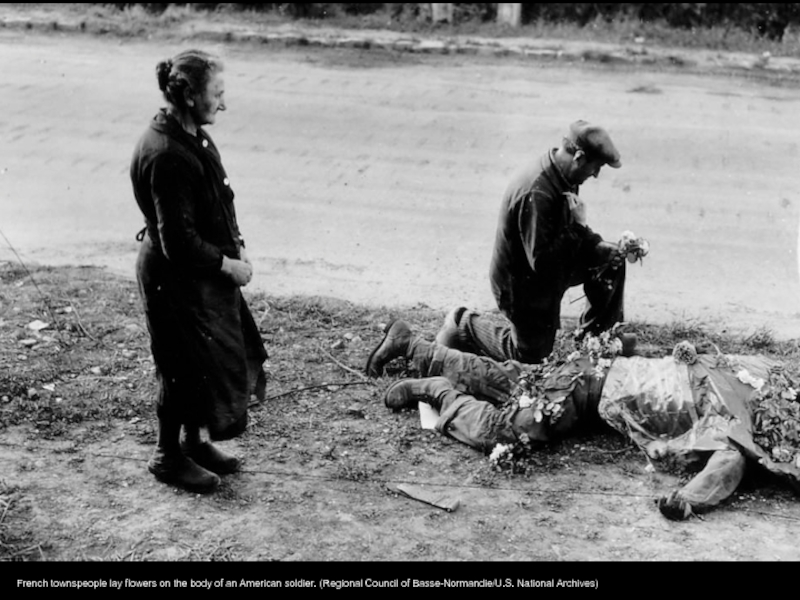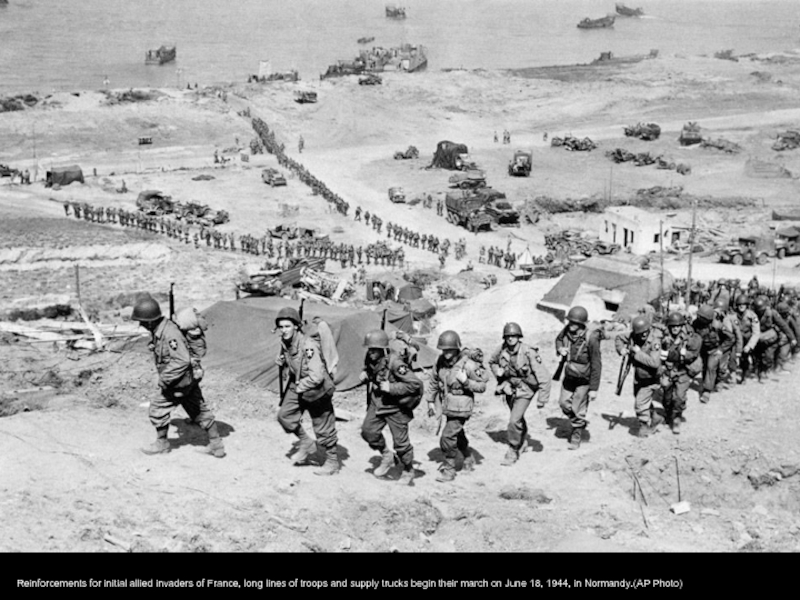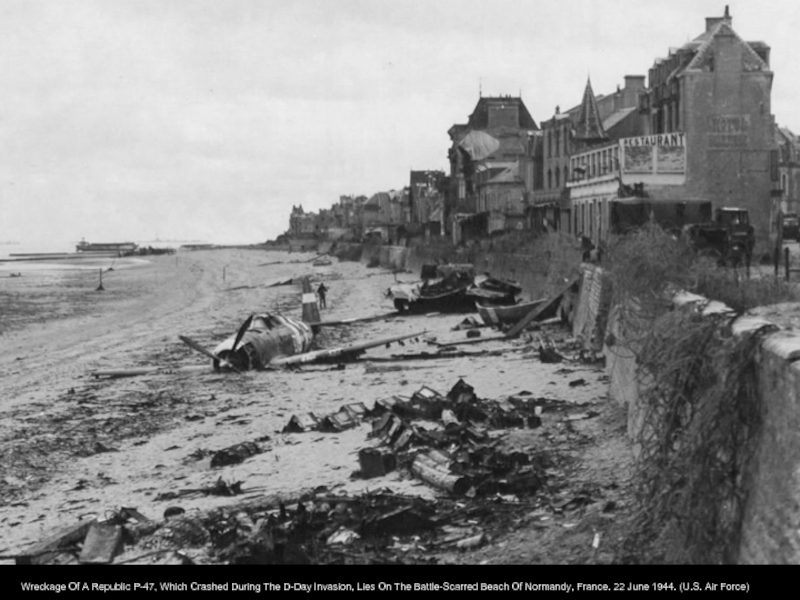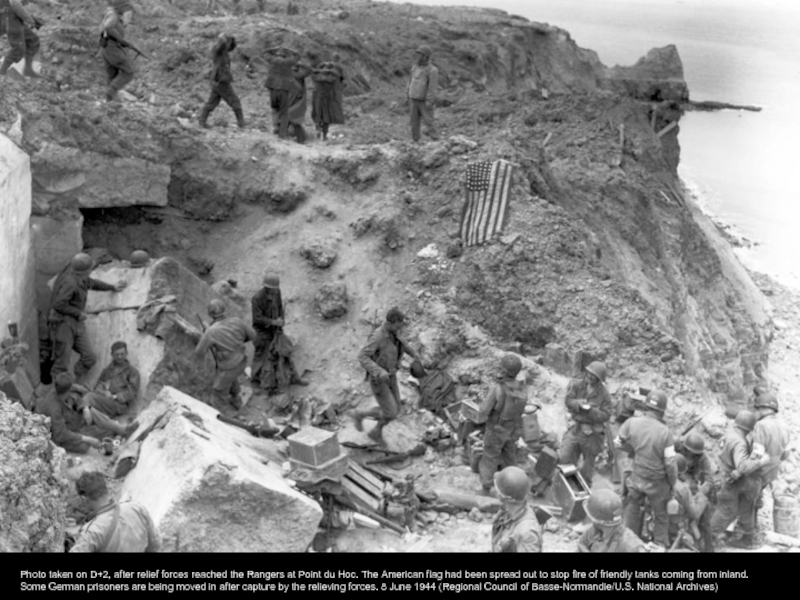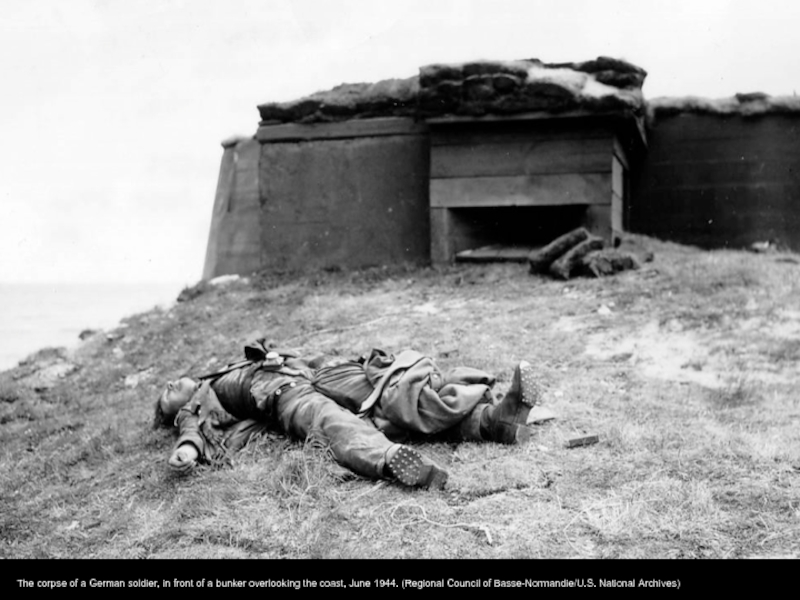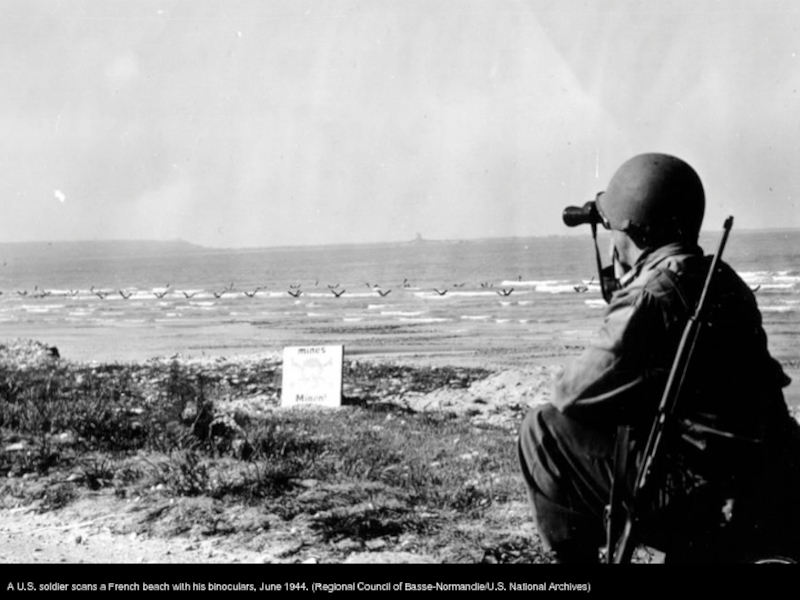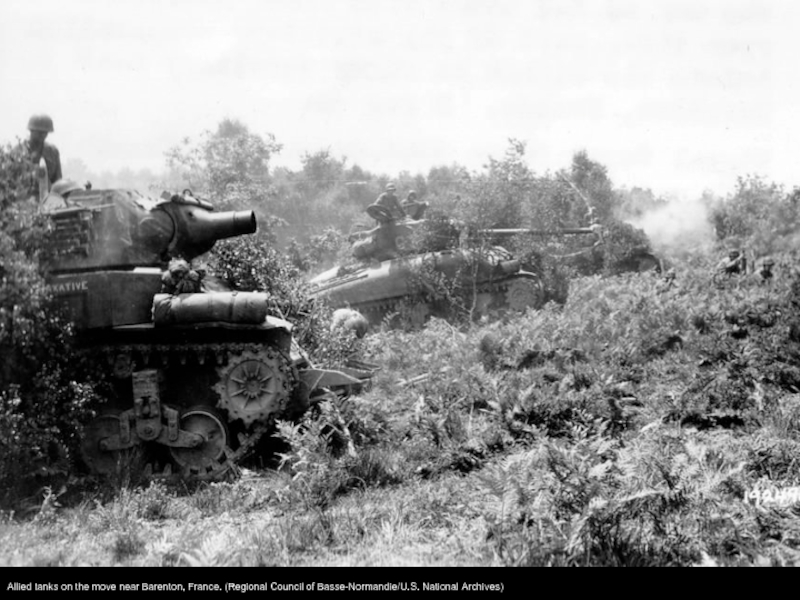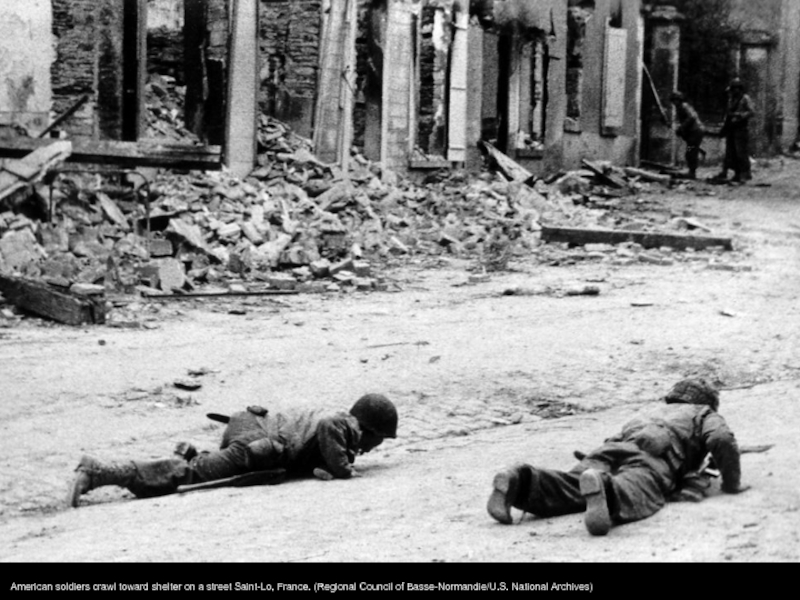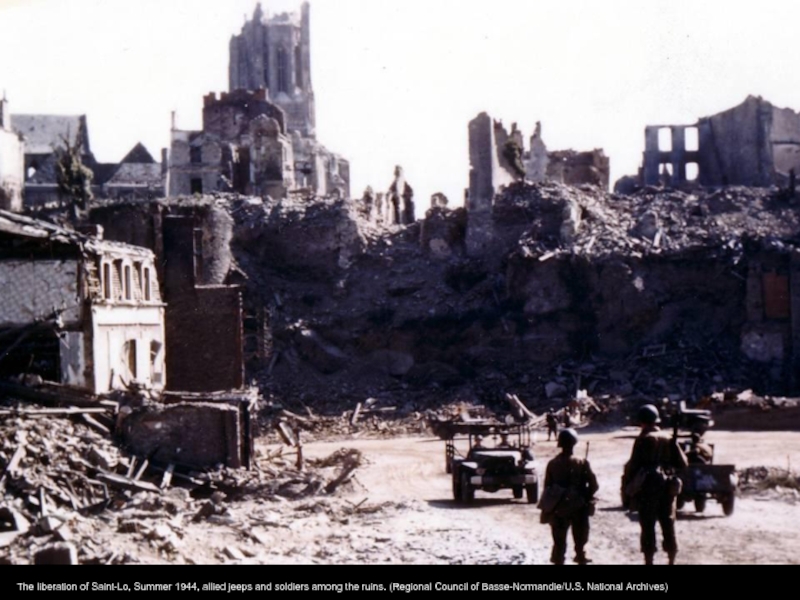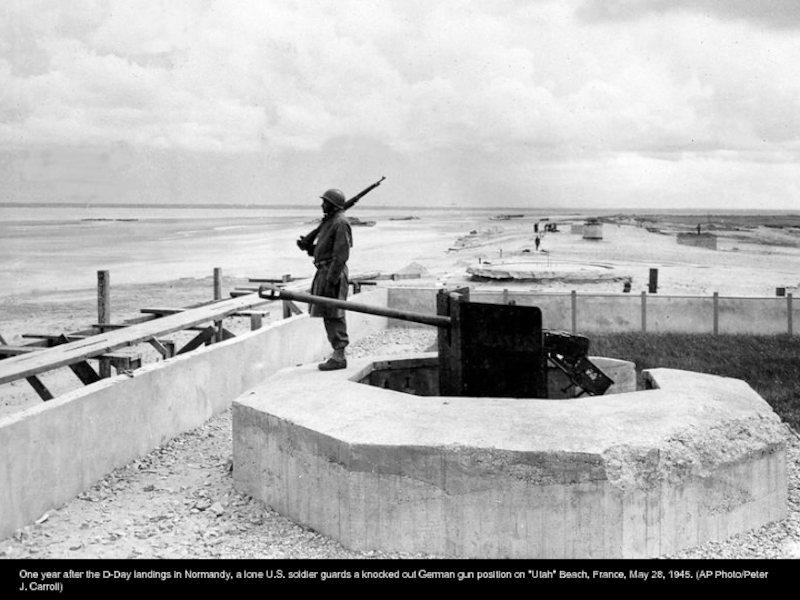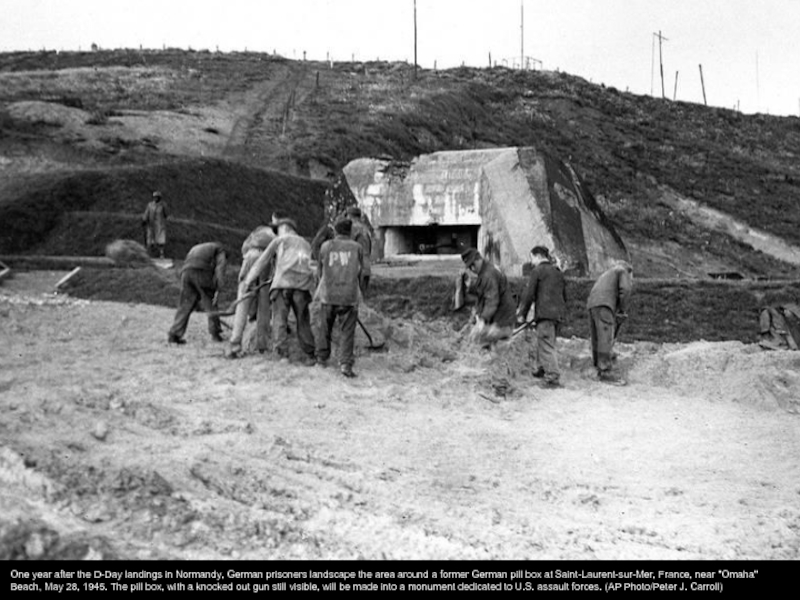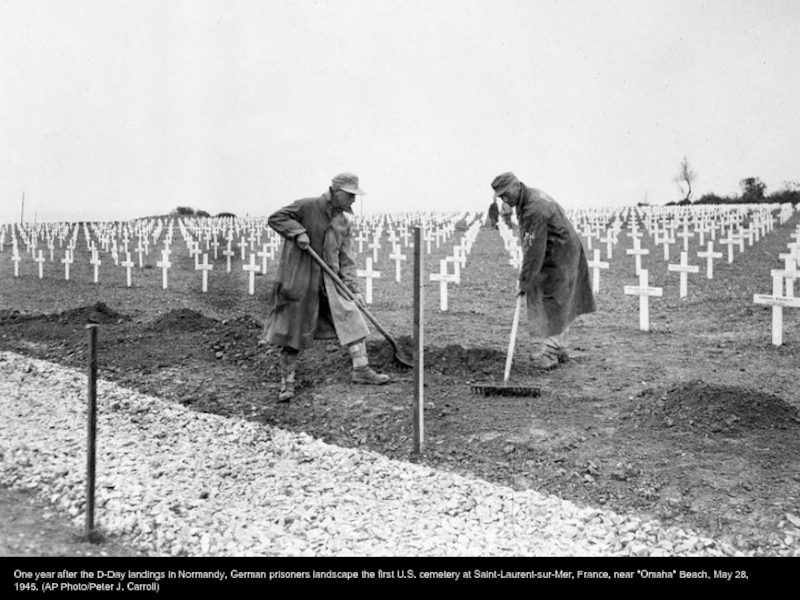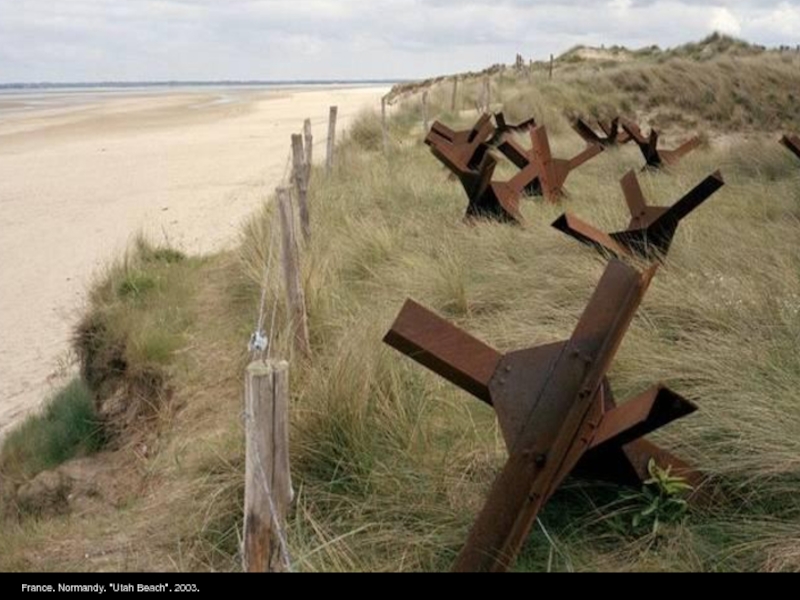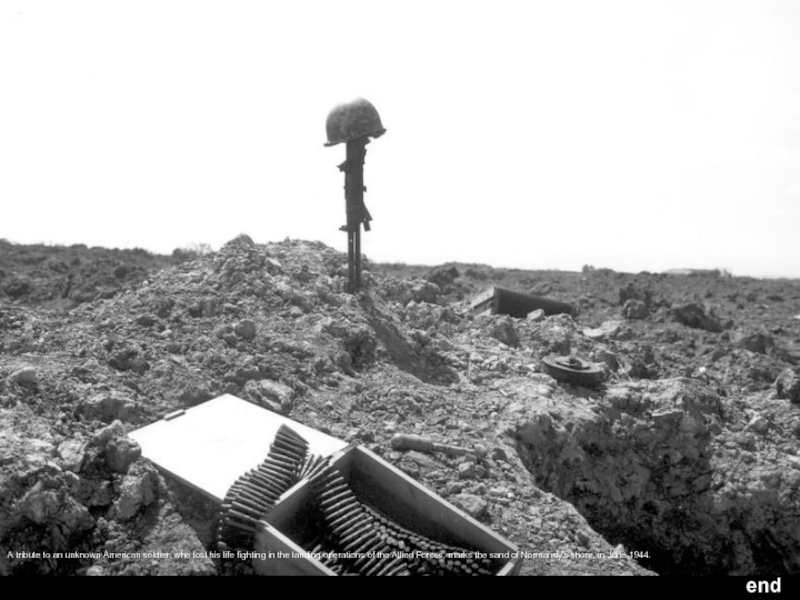- Главная
- Разное
- Дизайн
- Бизнес и предпринимательство
- Аналитика
- Образование
- Развлечения
- Красота и здоровье
- Финансы
- Государство
- Путешествия
- Спорт
- Недвижимость
- Армия
- Графика
- Культурология
- Еда и кулинария
- Лингвистика
- Английский язык
- Астрономия
- Алгебра
- Биология
- География
- Детские презентации
- Информатика
- История
- Литература
- Маркетинг
- Математика
- Медицина
- Менеджмент
- Музыка
- МХК
- Немецкий язык
- ОБЖ
- Обществознание
- Окружающий мир
- Педагогика
- Русский язык
- Технология
- Физика
- Философия
- Химия
- Шаблоны, картинки для презентаций
- Экология
- Экономика
- Юриспруденция
6 June 2014: 70th Anniversary of D-Day презентация
Содержание
- 4. 6 June 2014 70th anniversary of D-Day
- 5. Robert Capa Omaha Beach. June 6th, 1944
- 6. Robert Capa Omaha Beach. June 6th, 1944
- 7. Robert Capa Omaha Beach. June 6th, 1944
- 8. Robert Capa Omaha Beach. June 6th, 1944
- 9. Robert Capa Omaha Beach. June 6th, 1944
- 10. Robert Capa Omaha Beach. June 6th, 1944
- 11. Robert Capa Omaha Beach. June 6th, 1944
- 12. Robert Capa Omaha Beach. June 6th, 1944
- 13. Robert Capa Omaha Beach. June 6th, 1944
- 14. The enemy must be annihilated before he
- 16. Friday , June 6th, marks the 70th
- 17. A-20 bombers make a return visit to
- 18. German soldiers observe the coast during the
- 19. The sight of a low-flying Allied plane
- 20. U.S. Soldiers march through a southern English
- 21. General view of a port in England;
- 22. Coast Guard Flotilla 10 tied up along
- 23. Airborne troops prepare for the descent on
- 24. England. Dorset. Weymouth. June 5, 1944. American
- 25. Weymouth harbour in England on the eve
- 26. Supreme Commander Dwight Eisenhower gives the order
- 27. U.S. serviceman attend a Protestant service aboard
- 28. Weymouth harbour in England on the eve
- 29. FRANCE. Off the coast of Normandy. June
- 30. American paratroopers, heavily armed, sit inside a
- 31. U.S. paratroopers fix their static lines before
- 32. A convoy of Landing Craft Infantry (Large)
- 33. A section of the Armada of Allied
- 34. A U.S. Coast Guard LCI, heavily listing
- 35. Troops and vehicles on board a landing
- 36. USS LCI(L)-490 and USS LCI(L)-496 approach "Omaha"
- 37. Under the cover of naval shell fire,
- 38. Allied troop carriers near Omaha beach, one
- 39. US assault troops approach Utah Beach in
- 40. A convoy of Landing Craft Infantry (Large)
- 41. U.S. soldiers approach Omaha Beach, their weapons
- 42. American soldiers wade from Coast Guard landing
- 43. Omaha, 6:30. Allied forces push through the
- 44. View from inside landing craft approaching beach
- 45. View from inside landing craft shows US
- 46. U.S. troops disembark from a landing vehicle
- 47. Canadian troops in landing crafts approach a
- 48. Out of the open bow doors of
- 49. American soldiers and supplies arrive on the
- 50. Wounded British troops from the South Lancashire
- 51. Carrying full equipment, American assault troops move
- 52. American assault troops of the 3d Battalion,
- 53. U.S. soldiers land on Utah Beach, June 1944. (Regional Council of Basse-Normandie/U.S. National Archives)
- 54. An 88mm shell explodes on Utah Beach.
- 55. U.S. soldiers rescue shipwreck survivors on Utah
- 56. Dead Soldiers on "Omaha" beach on "D-Day",
- 57. German shell hits beside an LST off
- 58. An American Soldier lies dead alongside an
- 59. Just off Omaha Beach. American doctors on
- 60. Sitting in the cover of their foxholes,
- 61. U.S. Soldiers of the 8th Infantry Regiment,
- 62. An A-20 from the 416th Bomb Group
- 63. This June 6, 1944 photo released by
- 64. FRANCE. Normandy. June 6th, 1944. Omaha Beach.Photo Robert Capa
- 65. FRANCE. Normandy. June 6th, 1944. Omaha Beach. Photo Robert Capa
- 66. Aerial view of part of the Allied
- 67. Aerial view of the Normandy Invasion, on June 6th, 1944. (U.S. Air Force)
- 68. Thirteen liberty ships, deliberately scuttled to form
- 69. Above Omaha Beach, a German-placed bomb hangs
- 70. Allied soldiers, vehicles and equipment swarm onto
- 71. American soldiers on Omaha Beach recover the
- 72. U.S. reinforcements wade through the surf as
- 73. U.S. reinforcements wade through the surf from
- 74. U.S doughboys are brought ashore on the
- 75. Gliders towed by C-47 aircraft fly over
- 76. View of beach, one of the Allied
- 77. Section of Normandy beach at low tide
- 78. Omaha Beach. Serveral days after the landing. Photo Robert Capa
- 79. Two U.S. soldiers escort a group of
- 80. German prisoners of war are led away
- 81. June 1944. German soldiers captured after the landing. Photo Robert Capa
- 82. FRANCE. Normandy. Omaha Beach. June, 1944. French
- 83. US troops march up beachhead while landing
- 84. French townspeople lay flowers on the body
- 85. Reinforcements for initial allied invaders of France,
- 86. Wreckage Of A Republic P-47, Which Crashed
- 87. Photo taken on D+2, after relief forces
- 88. Three U.S. soldiers take a rest at
- 89. The corpse of a German soldier, in
- 90. A U.S. soldier scans a French beach
- 91. Allied tanks on the move near Barenton, France. (Regional Council of Basse-Normandie/U.S. National Archives)
- 92. U.S. soldiers move inland from the beaches
- 93. American soldiers crawl toward shelter on a
- 94. The liberation of Saint-Lo, Summer 1944, allied
- 95. American soldiers race across a dirt road,
- 96. One year after the D-Day landings in
- 97. One year after the D-Day landings in
- 98. One year after the D-Day landings in
- 99. cast
- 100. Gen. Dwight Eisenhower stands on the cliff
- 101. end A tribute to an unknown American
Слайд 14The enemy must be annihilated before he reaches our main battlefield...We
must stop him in the water...destroying all his equipment while it is still afloat.
Field Marshall Erwin Rommel - 22nd April 1944
Field Marshall Erwin Rommel - 22nd April 1944
Слайд 16Friday , June 6th, marks the 70th anniversary of the invasion
of Normandy.
On D-Day, June 6, 1944, Allied troops departed England on planes and ships, made the trip across the English Channel and attacked the beaches of Normandy in an attempt to break through Hitler’s “Atlantic Wall” and break his grip on Europe.
Several operations were combined to carry out the largest amphibious invasion in history - over 160,000 troops landed on June 6th, assisted by over 5,000 ships, aerial bombardment, gliders and paratroopers.
Thousands of soldiers lost their lives on those beaches on that day - many thousands more would follow as the invasion succeeded and troops began to push German forces eastward, eventually leading to the Allied victory in 1945.
Collected here are some photographs of the preparation, execution and immediate aftermath of the 1944 D-Day invasion of Normandy.
On D-Day, June 6, 1944, Allied troops departed England on planes and ships, made the trip across the English Channel and attacked the beaches of Normandy in an attempt to break through Hitler’s “Atlantic Wall” and break his grip on Europe.
Several operations were combined to carry out the largest amphibious invasion in history - over 160,000 troops landed on June 6th, assisted by over 5,000 ships, aerial bombardment, gliders and paratroopers.
Thousands of soldiers lost their lives on those beaches on that day - many thousands more would follow as the invasion succeeded and troops began to push German forces eastward, eventually leading to the Allied victory in 1945.
Collected here are some photographs of the preparation, execution and immediate aftermath of the 1944 D-Day invasion of Normandy.
Слайд 17A-20 bombers make a return visit to the Pointe Du Hoc
coastal battery on 22 May 1944. (U.S. National Archives)
Слайд 18German soldiers observe the coast during the occupation of Normandy by
German forces in 1944. (Regional Council of Basse-Normandie/U.S. National Archives)
Слайд 19The sight of a low-flying Allied plane sends Nazi soldiers rushing
for cover on a beach in France, before D-Day June 1944. The aircraft was taking reconnaissance photos of German coastal barriers in preparation for the June 6th invasion. (AP Photo)
Слайд 20U.S. Soldiers march through a southern English coastal town, en route
to board landing ships for the invasion of France, circa late May or early June 1944. (Army Signal Corps Collection/U.S. National Archives)
Слайд 21General view of a port in England; in foreground, jeeps are
being loaded onto landing craft - in background, larger trucks and ducks are being loaded, June 1944. (U.S. National Archives)
Слайд 22Coast Guard Flotilla 10 tied up along with British landing craft,
preparing to sail the English Channel and invade Nazi-occupied France. These landing craft landed U.S. troops on Omaha Beach. (U.S. Army)
Слайд 23Airborne troops prepare for the descent on Europe of D-Day invasion
June 6, 1944. (AP Photo)
Слайд 24England. Dorset. Weymouth. June 5, 1944. American troops in landing craft
at Weymouth on their way to liberate France. Photo Robert Capa
Слайд 26Supreme Commander Dwight Eisenhower gives the order of the day "Full
victory - Nothing else" to paratroopers of the 101st Airborne Division at the Royal Air Force base in Greenham Common, England, three hours before the men board their planes to participate in the first assault wave of the invasion of the continent of Europe, June 5, 1944. (AP Photo)
Слайд 27U.S. serviceman attend a Protestant service aboard a landing craft before
the D-Day invasion on the coast of France, June 5, 1944. (AP Photo/Pete Carroll)
Слайд 29FRANCE. Off the coast of Normandy. June 6th, 1944. American troops
transfer from troop ships to landing craft before assaulting Omaha Beach. Photo Robert Capa
Слайд 30American paratroopers, heavily armed, sit inside a military plane as they
soar over the English Channel en route to the Normandy French coast for the Allied D-Day invasion of the German stronghold during World War II, June 6, 1944. (AP Photo)
Слайд 31U.S. paratroopers fix their static lines before a jump before dawn
over Normandy on D-Day June 6, 1944, in France. The decision to launch the airborne attack in darkness instead of waiting for first light was probably one of the few Allied missteps on June 6, and there was much to criticize both in the training and equipment given to paratroopers and glider-borne troops of the 82nd and 101st airborne divisions. Improvements were called for after the invasion; the hard-won knowledge would be used to advantage later. (AP Photo/Army Signal Corps)
Слайд 32A convoy of Landing Craft Infantry (Large) sails across the English
Channel toward the Normandy Invasion beaches on "D-Day", 6 June 1944. Each of these landing craft is towing a barrage balloon for protection against low-flying German aircraft. (Photograph from the U.S. Coast Guard Collection in the U.S. National Archives.)
Слайд 33A section of the Armada of Allied landing craft with their
protective barrage balloons head toward the French coast, in June of 1944.(AP Photo)
Слайд 34A U.S. Coast Guard LCI, heavily listing to port, moves alongside
a transport ship to evacuate her troops, during the initial Normandy landing operations in France, on June 6, 1944. Moments later the craft will capsize and sink. (AP Photo)
Слайд 35Troops and vehicles on board a landing craft approaching "Omaha" Beach.
The original caption gives the date as 8 June 1944, but heavy smoke ashore strongly indicates that the photograph was taken on "D-Day", 6 June 1944. (Photograph from the Army Signal Corps Collection in the U.S. National Archives.)
Слайд 36USS LCI(L)-490 and USS LCI(L)-496 approach "Omaha" Beach.The original caption gives
date as 7 June 1944, but the heavy smoke ashore strongly indicates that the view was taken on "D-Day", 6 June 1944. (Photograph from the Army Signal Corps Collection in the U.S. National Archives.)
Слайд 37Under the cover of naval shell fire, American infantrymen wade ashore
from their landing craft during the initial Normandy landing operations in France, June 6, 1944. (AP Photo/Peter Carroll)
Слайд 38Allied troop carriers near Omaha beach, one covered with a thick
white smoke, June 1944. (Regional Council of Basse-Normandie/U.S. National Archives)
Слайд 39US assault troops approach Utah Beach in a barge, 06 June
1944 as Allied forces storm the Normand beaches on D-Day. D-Day, is still one of the world's most gut-wrenching and consequential battles, as the Allied landing in Normandy led to the liberation of France which marked the turning point in the Western theater of World War II. (Photo credit should read STF/AFP/Getty Images)
Слайд 40A convoy of Landing Craft Infantry (Large) sails across the English
Channel toward the Normandy Invasion beaches on "D-Day", 6 June 1944. Each of these landing craft is towing a barrage balloon for protection against low-flying German aircraft. (Photograph from the U.S. Coast Guard Collection in the U.S. National Archives.)
Слайд 41U.S. soldiers approach Omaha Beach, their weapons wrapped in plastic to
keep them dry, June 1944. (Regional Council of Basse-Normandie/U.S. National Archives)
Слайд 42American soldiers wade from Coast Guard landing barge toward the beach
at Normandy on D-Day, June 6, 1944. (U.S. National Archives)
Слайд 43Omaha, 6:30. Allied forces push through the breakers toward Omaha Beach.
(Regional Council of Basse-Normandie/U.S. National Archives)
Слайд 44View from inside landing craft approaching beach head on first day
of the invasion of Normandy, w. smoke rising from shelled German positions. June 6, 1944
Слайд 45View from inside landing craft shows US soldiers wading through surf
towards beachhead while barrage balloon float overhead during the first day of thel invasion of Normandy, aka D-Day.June 6, 1944
Слайд 46U.S. troops disembark from a landing vehicle on Utah Beach on
the coast of Normandy, France in June of 1944. Carcasses of destroyed vehicles litter the beach. (Regional Council of Basse-Normandie/U.S. National Archives)
Слайд 47Canadian troops in landing crafts approach a stretch of coastline code-named
Juno Beach, near Bernieres-sur-mer, as the Allied Normandy invasion gets under way, on June 6, 1944. (AP Photo)
Слайд 48Out of the open bow doors of a Landing Craft, American
troops and jeeps go ashore on the beach of the Normandy coast of France, June 6, 1944. (AP Photo)
Слайд 49American soldiers and supplies arrive on the shore of the French
coast of German-occupied Normandy during the Allied D-Day invasion on June 6, 1944 in World War II. (AP Photo)
Слайд 50Wounded British troops from the South Lancashire and Middlesex regiments are
being helped ashore at Sword Beach, June 6, 1944, during the D-Day invasion of German occupied France during World War II. (AP Photo)
Слайд 51Carrying full equipment, American assault troops move onto a beachhead code-named
Omaha Beach, on the northern coast of France on June 6, 1944, during the Allied invasion of the Normandy coast. (AP Photo)
Слайд 52American assault troops of the 3d Battalion, 16th Infantry Regiment, 1st
U.S. Infantry Division, assemble on a narrow strip at Omaha Beach before moving into the interior of the continent, near Collville-Sur-Mer, France. Additional infantrymen disembark from landing craft on the right. 6 Jun 1944.
Слайд 53U.S. soldiers land on Utah Beach, June 1944. (Regional Council of
Basse-Normandie/U.S. National Archives)
Слайд 54An 88mm shell explodes on Utah Beach. In the foreground, American
soldiers protect themselves from enemy fire. (Regional Council of Basse-Normandie/U.S. National Archives)
Слайд 55U.S. soldiers rescue shipwreck survivors on Utah Beach, June 1944. (Regional
Council of Basse-Normandie/U.S. National Archives)
Слайд 56Dead Soldiers on "Omaha" beach on "D-Day", 6 June 1944. They
were members of the 3rd Battalion, 16th Infantry Regiment, 1st Infantry Division. (Photograph from the Army Signal Corps Collection in the U.S. National Archives.)
Слайд 57German shell hits beside an LST off "Utah" Beach, during the
early stages of the landings on "D-Day", 6 June 1944.This LST appears to be very down at the stern. (Photograph from the Army Signal Corps Collection in the U.S. National Archives.)
Слайд 58An American Soldier lies dead alongside an anti-landing craft obstruction on
"Omaha" Beach, 6 June 1944. (Photograph from the U.S. Coast Guard Collection in the U.S. National Archives.)
Слайд 59Just off Omaha Beach. American doctors on a US craft during
Operation Overlord .Photo Robert Capa
Слайд 60Sitting in the cover of their foxholes, American soldiers of the
Allied Expeditionary Force secure a beachhead during initial landing operations at Normandy, France, June 6, 1944. In the background amphibious tanks and other equipment crowd the beach, while landing craft bring more troops and material ashore. (AP Photo/Weston Hayes)
Слайд 61U.S. Soldiers of the 8th Infantry Regiment, 4th Infantry Division, move
out over the seawall on "Utah" Beach, after coming ashore. Other troops are resting behind the concrete wall.Photo dated 9 June 1944, but probably taken on "D-Day", 6 June 1944. (Photograph from the Army Signal Corps Collection in the U.S. National Archives.)
Слайд 63This June 6, 1944 photo released by Nathan Kline, shows a
B-26 Marauder flying toward France during the D-Day invasion. (AP Photo/ Courtesy of Nathan Kline)
Слайд 66Aerial view of part of the Allied force off the coast
of France, on D-Day, 1944. (U.S. Air Force)
Слайд 68Thirteen liberty ships, deliberately scuttled to form a breakwater for invasion
vessels landing on the Normandy beachhead lie in line off the beach, shielding the ships in shore. The artificial harbor engineering installation which was prefabricated and towed across the Channel. 1944 photo. (AP Photo)
Слайд 69Above Omaha Beach, a German-placed bomb hangs on the side of
a cliff, as a defensive measure. (Regional Council of Basse-Normandie/U.S. National Archives)
Слайд 70Allied soldiers, vehicles and equipment swarm onto the French shore during
the Normandy landings, June 1944. (Regional Council of Basse-Normandie/U.S. National Archives)
Слайд 71American soldiers on Omaha Beach recover the dead after the D-Day
invasion, June 1944. (U.S. National Archives)
Слайд 72U.S. reinforcements wade through the surf as they land at Normandy
in the days following the Allies' June 1944, D-Day invasion of France. (AP Photo/Peter Carroll)
Слайд 73U.S. reinforcements wade through the surf from a landing craft in
the days following D-Day and the Allied invasion of Nazi-occupied France at Normandy in June 1944 during World War II. (AP Photo/Bert Brandt)
Слайд 74U.S doughboys are brought ashore on the Northern Coast of France
following the D-Day invasion of Normandy in World War II on June 13, 1944. The exhausted soldiers on the rubber life raft are being pulled by a group of comrades. (AP Photo/U.S. Army Signal Corps)
Слайд 75Gliders towed by C-47 aircraft fly over Utah Beach bringing reinforcements
on June 7th, 1944. (Regional Council of Basse-Normandie/U.S. National Archives)
Слайд 76View of beach, one of the Allied objectives on the coast
of France, showing masses of men and equipment being landed from various landing craft lying off-shore during World War II invasion of France.June 9, 1944
Слайд 77Section of Normandy beach at low tide shortly after the D-Day
invasion reveals bodies of the men who died as well as wrecked vehicles and, in the middle distance, tank traps left by the Germans to scuttle incoming Allied ships. June 12, 1944
Слайд 79Two U.S. soldiers escort a group of ten German prisoners on
Omaha Beach, June 1944. (Regional Council of Basse-Normandie/U.S. National Archives)
Слайд 80German prisoners of war are led away by Allied forces from
Utah Beach, on June 6, 1944, during landing operations at the Normandy coast, France. (AP Photo)
Слайд 82FRANCE. Normandy. Omaha Beach. June, 1944. French fishermen looking at corpses
on the beach after the D-Day landing. Photo Robert Capa
Слайд 83US troops march up beachhead while landing craft in rear continue
to unload supplies, equipment & men following victorious D-Day invasion.June 8, 1944
Слайд 84French townspeople lay flowers on the body of an American soldier.
(Regional Council of Basse-Normandie/U.S. National Archives)
Слайд 85Reinforcements for initial allied invaders of France, long lines of troops
and supply trucks begin their march on June 18, 1944, in Normandy.(AP Photo)
Слайд 86Wreckage Of A Republic P-47, Which Crashed During The D-Day Invasion,
Lies On The Battle-Scarred Beach Of Normandy, France. 22 June 1944. (U.S. Air Force)
Слайд 87Photo taken on D+2, after relief forces reached the Rangers at
Point du Hoc. The American flag had been spread out to stop fire of friendly tanks coming from inland. Some German prisoners are being moved in after capture by the relieving forces. 8 June 1944 (Regional Council of Basse-Normandie/U.S. National Archives)
Слайд 88Three U.S. soldiers take a rest at the foot of a
bunker which the Germans have painted and camouflaged to look like a house. (Regional Council of Basse-Normandie/U.S. National Archives)
Слайд 89The corpse of a German soldier, in front of a bunker
overlooking the coast, June 1944. (Regional Council of Basse-Normandie/U.S. National Archives)
Слайд 90A U.S. soldier scans a French beach with his binoculars, June
1944. (Regional Council of Basse-Normandie/U.S. National Archives)
Слайд 91Allied tanks on the move near Barenton, France. (Regional Council of
Basse-Normandie/U.S. National Archives)
Слайд 92U.S. soldiers move inland from the beaches of France, June 1944.
(Regional Council of Basse-Normandie/U.S. National Archives)
Слайд 93American soldiers crawl toward shelter on a street Saint-Lo, France. (Regional
Council of Basse-Normandie/U.S. National Archives)
Слайд 94The liberation of Saint-Lo, Summer 1944, allied jeeps and soldiers among
the ruins. (Regional Council of Basse-Normandie/U.S. National Archives)
Слайд 95American soldiers race across a dirt road, which is under enemy
fire, near St. Lo, in Normandy, France, on July 25, 1944. Others crouch in the ditch before making the crossing. (AP Photo)
Слайд 96One year after the D-Day landings in Normandy, a lone U.S.
soldier guards a knocked out German gun position on "Utah" Beach, France, May 28, 1945. (AP Photo/Peter J. Carroll)
Слайд 97One year after the D-Day landings in Normandy, German prisoners landscape
the area around a former German pill box at Saint-Laurent-sur-Mer, France, near "Omaha" Beach, May 28, 1945. The pill box, with a knocked out gun still visible, will be made into a monument dedicated to U.S. assault forces. (AP Photo/Peter J. Carroll)
Слайд 98One year after the D-Day landings in Normandy, German prisoners landscape
the first U.S. cemetery at Saint-Laurent-sur-Mer, France, near "Omaha" Beach, May 28, 1945. (AP Photo/Peter J. Carroll)
Слайд 99cast
6 June 2014 70th anniversary of D-Day
images credit www.
Music Yanni created olga.e. thanks for watching
images credit www.
Music Yanni created olga.e. thanks for watching
France. Normandy. "Utah Beach". 2003.
Слайд 100Gen. Dwight Eisenhower stands on the cliff overlooking Omaha Beach on
the Normandy coast in France as he makes an anniversary visit to the scene of the 1945 D-Day landing of the Allied troops, June 9, 1951. (AP Photo)
Слайд 101end
A tribute to an unknown American soldier, who lost his life
fighting in the landing operations of the Allied Forces, marks the sand of Normandy's shore, in June 1944.
